6.11: Romanesque
- Page ID
- 73549
\( \newcommand{\vecs}[1]{\overset { \scriptstyle \rightharpoonup} {\mathbf{#1}} } \)
\( \newcommand{\vecd}[1]{\overset{-\!-\!\rightharpoonup}{\vphantom{a}\smash {#1}}} \)
\( \newcommand{\dsum}{\displaystyle\sum\limits} \)
\( \newcommand{\dint}{\displaystyle\int\limits} \)
\( \newcommand{\dlim}{\displaystyle\lim\limits} \)
\( \newcommand{\id}{\mathrm{id}}\) \( \newcommand{\Span}{\mathrm{span}}\)
( \newcommand{\kernel}{\mathrm{null}\,}\) \( \newcommand{\range}{\mathrm{range}\,}\)
\( \newcommand{\RealPart}{\mathrm{Re}}\) \( \newcommand{\ImaginaryPart}{\mathrm{Im}}\)
\( \newcommand{\Argument}{\mathrm{Arg}}\) \( \newcommand{\norm}[1]{\| #1 \|}\)
\( \newcommand{\inner}[2]{\langle #1, #2 \rangle}\)
\( \newcommand{\Span}{\mathrm{span}}\)
\( \newcommand{\id}{\mathrm{id}}\)
\( \newcommand{\Span}{\mathrm{span}}\)
\( \newcommand{\kernel}{\mathrm{null}\,}\)
\( \newcommand{\range}{\mathrm{range}\,}\)
\( \newcommand{\RealPart}{\mathrm{Re}}\)
\( \newcommand{\ImaginaryPart}{\mathrm{Im}}\)
\( \newcommand{\Argument}{\mathrm{Arg}}\)
\( \newcommand{\norm}[1]{\| #1 \|}\)
\( \newcommand{\inner}[2]{\langle #1, #2 \rangle}\)
\( \newcommand{\Span}{\mathrm{span}}\) \( \newcommand{\AA}{\unicode[.8,0]{x212B}}\)
\( \newcommand{\vectorA}[1]{\vec{#1}} % arrow\)
\( \newcommand{\vectorAt}[1]{\vec{\text{#1}}} % arrow\)
\( \newcommand{\vectorB}[1]{\overset { \scriptstyle \rightharpoonup} {\mathbf{#1}} } \)
\( \newcommand{\vectorC}[1]{\textbf{#1}} \)
\( \newcommand{\vectorD}[1]{\overrightarrow{#1}} \)
\( \newcommand{\vectorDt}[1]{\overrightarrow{\text{#1}}} \)
\( \newcommand{\vectE}[1]{\overset{-\!-\!\rightharpoonup}{\vphantom{a}\smash{\mathbf {#1}}}} \)
\( \newcommand{\vecs}[1]{\overset { \scriptstyle \rightharpoonup} {\mathbf{#1}} } \)
\( \newcommand{\vecd}[1]{\overset{-\!-\!\rightharpoonup}{\vphantom{a}\smash {#1}}} \)
\(\newcommand{\avec}{\mathbf a}\) \(\newcommand{\bvec}{\mathbf b}\) \(\newcommand{\cvec}{\mathbf c}\) \(\newcommand{\dvec}{\mathbf d}\) \(\newcommand{\dtil}{\widetilde{\mathbf d}}\) \(\newcommand{\evec}{\mathbf e}\) \(\newcommand{\fvec}{\mathbf f}\) \(\newcommand{\nvec}{\mathbf n}\) \(\newcommand{\pvec}{\mathbf p}\) \(\newcommand{\qvec}{\mathbf q}\) \(\newcommand{\svec}{\mathbf s}\) \(\newcommand{\tvec}{\mathbf t}\) \(\newcommand{\uvec}{\mathbf u}\) \(\newcommand{\vvec}{\mathbf v}\) \(\newcommand{\wvec}{\mathbf w}\) \(\newcommand{\xvec}{\mathbf x}\) \(\newcommand{\yvec}{\mathbf y}\) \(\newcommand{\zvec}{\mathbf z}\) \(\newcommand{\rvec}{\mathbf r}\) \(\newcommand{\mvec}{\mathbf m}\) \(\newcommand{\zerovec}{\mathbf 0}\) \(\newcommand{\onevec}{\mathbf 1}\) \(\newcommand{\real}{\mathbb R}\) \(\newcommand{\twovec}[2]{\left[\begin{array}{r}#1 \\ #2 \end{array}\right]}\) \(\newcommand{\ctwovec}[2]{\left[\begin{array}{c}#1 \\ #2 \end{array}\right]}\) \(\newcommand{\threevec}[3]{\left[\begin{array}{r}#1 \\ #2 \\ #3 \end{array}\right]}\) \(\newcommand{\cthreevec}[3]{\left[\begin{array}{c}#1 \\ #2 \\ #3 \end{array}\right]}\) \(\newcommand{\fourvec}[4]{\left[\begin{array}{r}#1 \\ #2 \\ #3 \\ #4 \end{array}\right]}\) \(\newcommand{\cfourvec}[4]{\left[\begin{array}{c}#1 \\ #2 \\ #3 \\ #4 \end{array}\right]}\) \(\newcommand{\fivevec}[5]{\left[\begin{array}{r}#1 \\ #2 \\ #3 \\ #4 \\ #5 \\ \end{array}\right]}\) \(\newcommand{\cfivevec}[5]{\left[\begin{array}{c}#1 \\ #2 \\ #3 \\ #4 \\ #5 \\ \end{array}\right]}\) \(\newcommand{\mattwo}[4]{\left[\begin{array}{rr}#1 \amp #2 \\ #3 \amp #4 \\ \end{array}\right]}\) \(\newcommand{\laspan}[1]{\text{Span}\{#1\}}\) \(\newcommand{\bcal}{\cal B}\) \(\newcommand{\ccal}{\cal C}\) \(\newcommand{\scal}{\cal S}\) \(\newcommand{\wcal}{\cal W}\) \(\newcommand{\ecal}{\cal E}\) \(\newcommand{\coords}[2]{\left\{#1\right\}_{#2}}\) \(\newcommand{\gray}[1]{\color{gray}{#1}}\) \(\newcommand{\lgray}[1]{\color{lightgray}{#1}}\) \(\newcommand{\rank}{\operatorname{rank}}\) \(\newcommand{\row}{\text{Row}}\) \(\newcommand{\col}{\text{Col}}\) \(\renewcommand{\row}{\text{Row}}\) \(\newcommand{\nul}{\text{Nul}}\) \(\newcommand{\var}{\text{Var}}\) \(\newcommand{\corr}{\text{corr}}\) \(\newcommand{\len}[1]{\left|#1\right|}\) \(\newcommand{\bbar}{\overline{\bvec}}\) \(\newcommand{\bhat}{\widehat{\bvec}}\) \(\newcommand{\bperp}{\bvec^\perp}\) \(\newcommand{\xhat}{\widehat{\xvec}}\) \(\newcommand{\vhat}{\widehat{\vvec}}\) \(\newcommand{\uhat}{\widehat{\uvec}}\) \(\newcommand{\what}{\widehat{\wvec}}\) \(\newcommand{\Sighat}{\widehat{\Sigma}}\) \(\newcommand{\lt}{<}\) \(\newcommand{\gt}{>}\) \(\newcommand{\amp}{&}\) \(\definecolor{fillinmathshade}{gray}{0.9}\)Romanesque art
Pilgrimages, crusades and the first international style of art since antiquity: the Romanesque.
c. 1000 - 1200 C.E.
Beginner’s guide: Romanesque art
One influence, as the name implies, is ancient Roman art.
c. 1000 - 1200
The Romanesque is the first international style in Western Europe since antiquity. The transmission of ideas was facilitated by increased travel along the pilgrimage routes and because of the crusades.
A beginner’s guide to Romanesque art
The first international style since antiquity
The term “Romanesque,” meaning in the manner of the Romans, was first coined in the early nineteenth century. Today it is used to refer to the period of European art from the second half of the eleventh century throughout the twelfth (with the exception of the region around Paris where the Gothic style emerged in the mid-twelfth century). In certain regions, such as central Italy, the Romanesque continued to survive into the thirteenth century. The Romanesque is the first international style in Western Europe since antiquity—extending across the Mediterranean and as far north as Scandinavia. The transmission of ideas was facilitated by increased travel along the pilgrimage routes to shrines such as Santiago de Compostela in Spain (a pilgrimage is a journey to a sacred place) or as a consequence of the crusades which passed through the territories of the Byzantine empire. There are, however, distinctive regional variants—Tuscan Romanesque art (in Italy) for example is very different from that produced in northern Europe.
Painting + sculpture + architecture

The relation of art to architecture—especially church architecture—is fundamental in this period. For example, wall-paintings may follow the curvature of the apse of a church as in the apse wall-painting from the church of San Clemente in Taüll, and the most important art form to emerge at this period was architectural sculpture—with sculpture used to decorate churches built of stone.
Many sculptors may have begun their career as stone masons, and there is a remarkable coherence between architecture and sculpture in churches at this period. The two most important sculptural forms to emerge at this time were the tympanum (the lunette-shaped space above the entrance to a church), and the historiated capital (a capital incorporating a narrative element usually an episode from the Bible or the life of a saint). One of the most famous tympanums is on the west entrance to Autun Cathedral (below) which represents—appropriately for this part of the church—the Last Judgment. An inscription (Gislebertus hoc fecit” “Gislebertus made me”), at the base of the giant immobile figure of Christ at the center, records the name of the artist or head of the workshop which produced it, though it has been suggested that it may refer to the original patron who was responsible for bringing the relics of Lazurus to Autun in the Carolingian period.

The influence of ancient Rome

One influence on the Romanesque is, as the name implies, ancient Roman art—especially sculpture—which survived in large quantities particularly in southern Europe. This can be seen, for example, in a marble relief representing the calling of St. Peter and St. Andrew from the front frieze of the abbey church of Sant Pere de Rodes on the Catalonian coast. The imprint of the antique can be seen in the deep undercutting in the drapery folds, an effect achieved by the Roman device of the drill, and the individualization of the faces.
Classical influence was also frequently mediated through an intermediary—most importantly Byzantine art (especially textiles and painting), but also through earlier medieval styles which had absorbed elements of the classical tradition such as Ottonian art.

The illustrations in the Bury Bible have, for example, been convincingly compared to Byzantine wall-paintings in a church at Asinou in Cyprus which suggests that its artist—a certain Master Hugo (having the name of the artist is unusual during this period) had seen them or a similar source. Monasteries such as that of Bury St. Edmunds in East Anglia in England (where the Bury Bible was made) were important centers of production—especially for the writing and decorating of manuscripts. The Bury Bible is a good example of the remarkable achievements of monastic scriptoria in the Romanesque period.
Monasteries were not the only centers of production. Romanesque art is also associated with towns that were revived and expanded during this period—for the first time since the fall of the Roman empire—a consequence of broad economic expansion (examples include Assisi in Umbria with its Romanesque cathedral or the newly founded town of Puente La Reina in northern Spain on the pilgrimage route to Santiago de Compostela).

Romanesque art is for the most part religious in its imagery, but this is partly a matter of what has survived, and there are examples of secular art from the period. Unusual is a casket in The British Museum, a product of Limoges craftsmanship, which is made of wood with champlevé enamels attached to it (produced by heating powdered glass set into groves hollowed out of bronze plate). This is decorated with scenes to do with courtly love inspired by troubadour poets from Provence.
Metalwork

The distinction between the fine and decorative arts is one that emerges only in the Renaissance and does not apply at this earlier period. If anything the most highly valued works of art during the Romanesque period were objects of metalwork made from precious metals that were frequently produced to house relics (characteristically the body part of a saint, or—in the case of Christ who, the faithful believe ascended to heaven—objects associated with him such as fragments of the so-called true cross on which Christ was thought to have been crucified).
An example of this is the reliquary known as the Stavelot Triptych. It consists of a central panel flanked by side wings that can be closed, a design format derived from Byzantine art but made at the Benedictine monastery of Stavelot in the Mosan region in present day Belgium in the mid-twelfth century. The triptych was commissioned by the abbot, a man called Wibald, whom we know travelled extensively and who acquired, during a trip to Constantinople, the two Byzantine enamel plaques incorporated into the center of the triptych that contain what were believed to be fragments of the true cross.
A wall painting from San Clemente in Catalonia
The apse wall-painting from the church of San Clemente is a good example of the Romanesque style. The church is situated in a remote valley in northern Catalonia (north-east Spain today) and is typical of the handsome stone-built churches which sprung up in this region in the Romanesque period. The painting would have been painted onto fresh plaster applied to the walls of the church (it was transferred for safekeeping to the Museum of Catalan Art in Barcelona early in the twentieth century). The painting is dominated by the giant figure of Christ in a mandorla (a halo around the body of a sacred person), represented as he will appear at the end of time as described in the Book of Revelation.


Christ is represented characteristically out of scale to the other figures to indicate his status. His head is distorted, elongated and highly geometric, and he has piercing hypnotic eyes. To either side of him are written the Greek letters “alpha” and “omega” (the beginning and the end), and with one hand he gestures in blessing, while the other holds an open book with the words Ego sum lux mundi (I am the light of the world) inscribed on it. Below him is an equally elongated and distorted figure of the Virgin Mary who holds a chalice with Christ’s blood, a representation of the Holy Grail which predates the earliest written description of the subject. Her presence in the scheme is symptomatic of the growing cult of the Virgin Mary at this period.
It would be just as much a mistake to regard the lack of naturalism found in this painting as indicating lack of artistic competence as it would be in a work by Picasso. Rather it indicates that its artist (whose real name we do not know) is not interested in replicating external appearances but rather in conveying a sense of the sacred and communicating the religious teachings of the church. Picasso (who was brought up in Barcelona) greatly admired Catalonian Romanesque, and it is significant that later in his life he kept a poster of this painting in his studio in southern France. We live in a world saturated with images but in the Romanesque period people would rarely encounter them and an image such as this would have made an immense impression.
Additional resources:
Romanesque art on The Metropolitan Museum of Art’s Heilbrunn Timeline of Art History
Romanesque art at the National Museum of Catalan art (video)
Smarthistory images for teaching and learning:
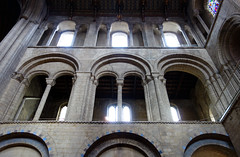

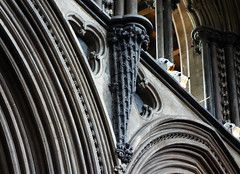
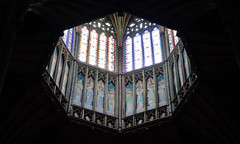
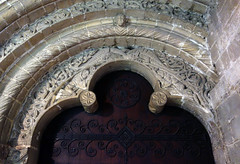
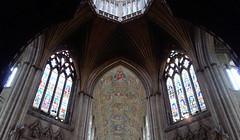
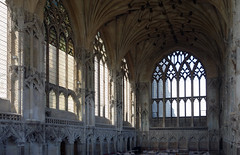
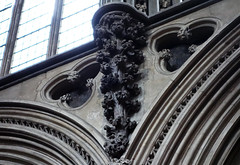
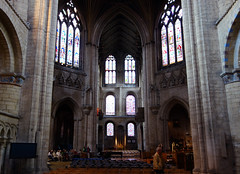
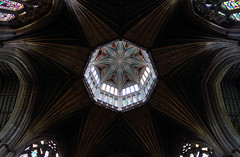
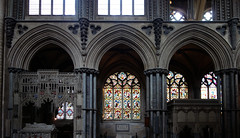

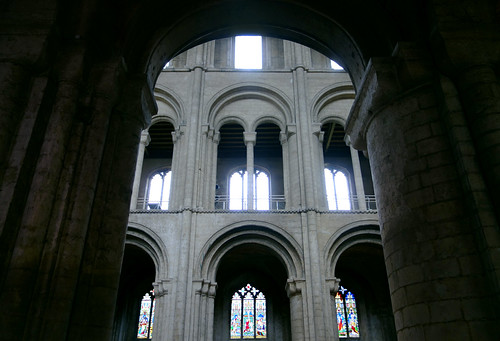
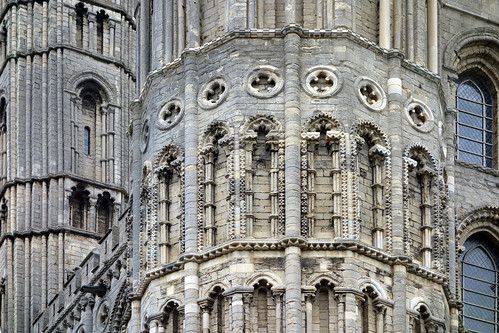
A beginner’s guide to Romanesque architecture
The name gives it away–Romanesque architecture is based on Roman architectural elements. It is the rounded Roman arch that is the literal basis for structures built in this style.
Ancient Roman ruins (with arches)
All through the regions that were part of the ancient Roman Empire are ruins of Roman aqueducts and buildings, most of them exhibiting arches as part of the architecture (you may make the etymological leap that the two words—arch and architecture—are related, but the Oxford English Dictionary shows arch as coming from Latin arcus, which defines the shape, while arch—as in architect, archbishop and archenemy—comes from Greek arkhos, meaning chief and ekton means builder).

When Charlemagne was crowned Holy Roman Emperor in 800 C.E., Europe began to take its first steps out of the “Dark Ages” since the fall of Rome in the fifth century. The remains of Roman civilization were seen all over the continent, and legends of the great empire would have been passed down through generations. So when Charlemagne wanted to unite his empire and validate his reign, he began building churches in the Roman style–particularly the style of Christian Rome in the days of Constantine, the first Christian Roman emperor.
After a gap of around two hundred years with no large building projects, the architects of Charlemagne’s day looked to the arched, or arcaded, system seen in Christian Roman edifices as a model. It is a logical system of stresses and buttressing, which was fairly easily engineered for large structures, and it began to be used in gatehouses, chapels, and churches in Europe.
These early examples may be referred to as pre-Romanesque because, after a brief spurt of growth, the development of architecture again lapsed. As a body of knowledge was eventually re-developed, buildings became larger and more imposing. Examples of Romanesque cathedrals from the early Middle Ages (roughly 1000-1200) are solid, massive, impressive churches that are often still the largest structure in many towns.
In Britain, the Romanesque style became known as “Norman” because the major building scheme in the 11th and 12th centuries was instigated by William the Conqueror, who invaded Britain in 1066 from Normandy in northern France. (The Normans were the descendants of Vikings—Norse, or north men—who had invaded this area over a century earlier.) Durham and Gloucester Cathedrals and Southwell Minster are excellent examples of churches in the Norman, or Romanesque style.
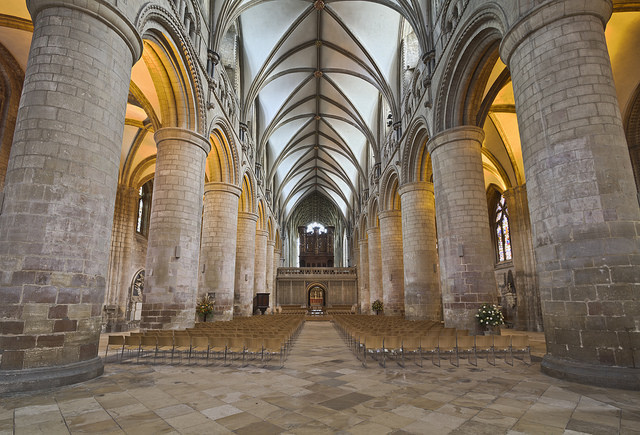
The arches that define the naves of these churches are well modulated and geometrically logical—with one look you can see the repeating shapes, and proportions that make sense for an immense and weighty structure. There is a large arcade on the ground level made up of bulky piers or columns. The piers may have been filled with rubble rather than being solid, carved stone. Above this arcade is a second level of smaller arches, often in pairs with a column between the two. The next higher level was again proportionately smaller, creating a rational diminution of structural elements as the mass of the building is reduced.

The decoration is often quite simple, using geometric shapes rather than floral or curvilinear patterns. Common shapes used include diapers—squares or lozenges—and chevrons, which were zigzag patterns and shapes. Plain circles were also used, which echoed the half-circle shape of the ubiquitous arches.
Early Romanesque ceilings and roofs were often made of wood, as if the architects had not quite understood how to span the two sides of the building using stone, which created outward thrust and stresses on the side walls. This development, of course, didn’t take long to manifest, and led from barrel vaulting (simple, semicircular roof vaults) to cross vaulting, which became ever more adventurous and ornate in the Gothic.
Additional resources:
Smarthistory images for teaching and learning:

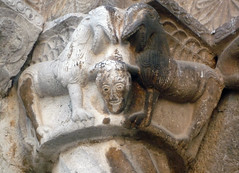
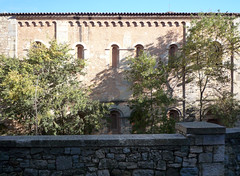
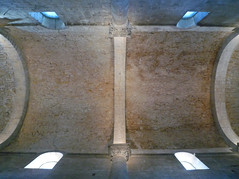
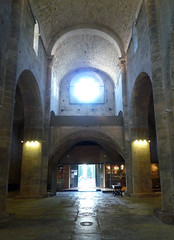
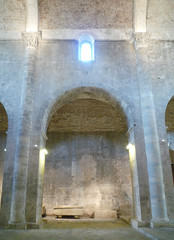

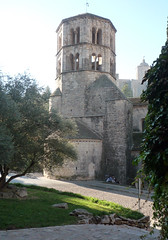
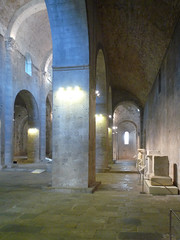
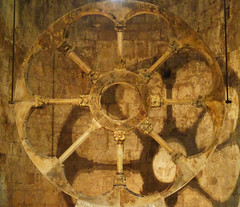

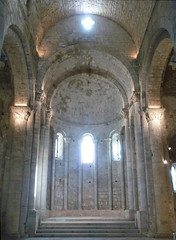
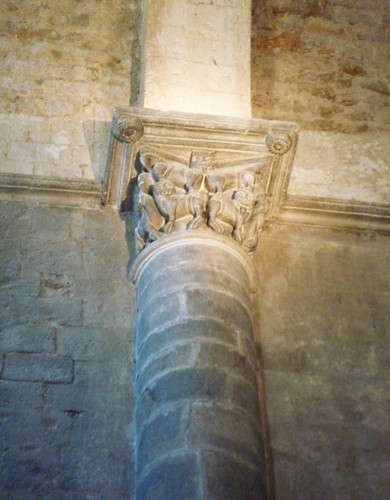

Medieval churches: sources and forms

Many of Europe’s medieval cathedrals are museums in their own right, housing fantastic examples of craftsmanship and works of art. Additionally, the buildings themselves are impressive. Although architectural styles varied from place to place, building to building, there are some basic features that were fairly universal in monumental churches built in the Middle Ages, and the prototype for that type of building was the Roman basilica.
Prototype: The ancient Roman basilica
In ancient Rome, the basilica was created as a place for tribunals and other types of business. The building was rectangular in shape, with the long, central portion of the hall made up of the nave. Here the interior reached its fullest height. The nave was flanked on either side by a colonnade (a row of columns) that delineated the side aisles, which were of a lower height than the nave. Because these side aisles were lower, the roof over this section was below the roofline of the nave, allowing for windows near the ceiling of the nave. This band of windows was called the clerestory. At the far end of the nave, away from the main door, was a semi-circular extension, usually with a half-dome roof. This area was the apse, and is where the magistrate or other senior officials would hold court.

Because this plan allowed for many people to circulate within a large, and awesome, space, the general plan became an obvious choice for early Christian buildings. The religious rituals, masses, and pilgrimages that became commonplace by the Middle Ages were very different from today’s services, and to understand the architecture it is necessary to understand how the buildings were used and the components that made up these massive edifices.

The church plan
Although medieval churches are usually oriented with the altar on the east end, they all vary slightly. When a new church was to be built, the patron saint was selected and the altar location laid out. On the saint’s day, a line would be surveyed from the position of the rising sun through the altar site and extending in a westerly direction. This was the orientation of the new building.
The entrance foyer at the west end is called the narthex, but this is not found in all medieval churches. Daily access may be through a door on the north or south side. The largest, central, western door may have been reserved for ceremonial purposes.

Inside, you should imagine the interior space without the chairs or pews that we are used to seeing today. In very extensive buildings there may be two side aisles, with the ceiling of the outer one lower than the one next to the nave. This hierarchy of size and proportion extended to the major units of the plan—the bays. The vault is the arched roof or ceiling, or a section of it.

The major arcade (row of arches) at the ground floor level is topped by a second arcade, called the gallery, which is topped by the clerestory (the windows). In later Gothic churches, we sometimes see yet another level below the clerestory, called the triforium.
The nave was used for the procession of the clergy to the altar. The main altar was basically in the position of the apse in the ancient Roman basilica, although in some designs it is further forward. The area around the altar—the choir or chancel—was reserved for the clergy or monks, who performed services throughout the day.
The cathedrals and former monastery churches are much larger than needed for the local population. They expected and received numerous pilgrims who came to various shrines and altars within the church where they might pray to a supposed piece of the true cross, or a bone of a martyr, or the tomb of a king. The pilgrims entered the church and found their way to the chapel or altar of their desire—therefore, the side aisles made an efficient path for pilgrims to come and go without disrupting the daily services.

Development of this plan over time shows that very soon the apse was elongated, adding more room to the choir. Additionally, the ends of the aisles developed into small wings themselves, known as transepts. These were also extended, providing room for more tombs, more shrines, and more pilgrims.
The area where the axes of the nave and transepts meet is called, logically, the crossing.

An aisle often surrounds the apse, running behind the altar. Called the ambulatory, this aisle accessed additional small chapels, called radiating chapels or chevets. Of course, there are many variations on these typical building blocks of medieval church design. Different regions had different tastes, greater or lesser financial power, more or less experienced architects and masons, which created the diversity of medieval buildings still standing today.
Smarthistory images for teaching and learning:









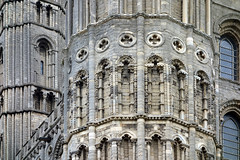


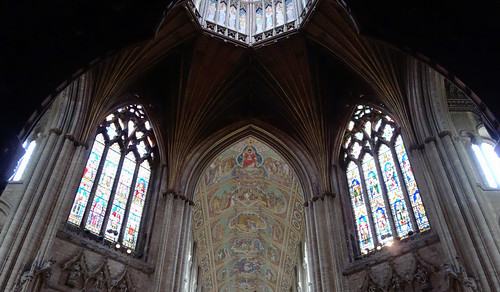
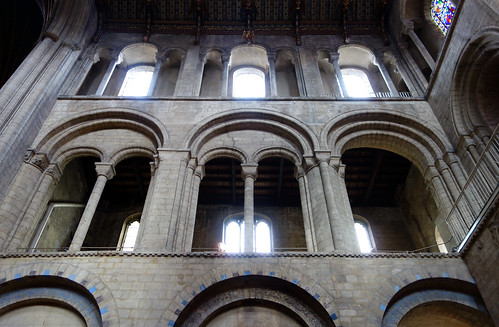
Pilgrimage routes and the cult of the relic

The end of the world
Y2K. The Rapture. 2012. For over a decade, speculation about the end of the world has run rampant—all in conjunction with the arrival of the new millennium. The same was true for our religious European counterparts who, prior to the year 1000, believed the Second Coming of Christ was imminent, and the end was nigh.
When the apocalypse failed to materialize in 1000, it was decided that the correct year must be 1033, a thousand years from the death of Jesus Christ, but then that year also passed without any cataclysmic event.
Just how extreme the millennial panic was, remains debated. It is certain that from the year 950 onwards, there was a significant increase in building activity, particularly of religious structures. There were many reasons for this construction boom beside millennial panic, and the building of monumental religious structures continued even as fears of the immediate end of time faded.
Not surprisingly, this period also witnessed a surge in the popularity of the religious pilgrimage. A pilgrimage is a journey to a sacred place. These are acts of piety and may have been undertaken in gratitude for the fact that doomsday had not arrived, and to ensure salvation, whenever the end did come.

The pilgrimage to Santiago de Compostela

For the average European in the 12th Century, a pilgrimage to the Holy Land of Jerusalem was out of the question—travel to the Middle East was too far, too dangerous and too expensive. Santiago de Compostela in Spain offered a much more convenient option.
To this day, hundreds of thousands of faithful travel the “Way of Saint James” to the Spanish city of Santiago de Compostela. They go on foot across Europe to a holy shrine where bones, believed to belong to Saint James, were unearthed. The Cathedral of Santiago de Compostela now stands on this site.
The pious of the Middle Ages wanted to pay homage to holy relics, and pilgrimage churches sprang up along the route to Spain. Pilgrims commonly walked barefoot and wore a scalloped shell, the symbol of Saint James (the shell’s grooves symbolize the many roads of the pilgrimage).
In France alone there were four main routes toward Spain. Le Puy, Arles, Paris and Vézelay are the cities on these roads and each contains a church that was an important pilgrimage site in its own right.
Why make a pilgrimage?
A pilgrimage to Santiago de Compostela was an expression of Christian devotion and it was believed that it could purify the soul and perhaps even produce miraculous healing benefits. A criminal could travel the “Way of Saint James” as an act penance. For the everyday person, a pilgrimage was also one of the only opportunities to travel and see some of the world. It was a chance to meet people, perhaps even those outside one’s own class. The purpose of pilgrimage may not have been entirely devotional.
The cult of the relic

Pilgrimage churches can be seen in part as popular desinations, a spiritual tourism of sorts for medieval travelers. Guidebooks, badges and various souvenirs were sold. Pilgrims, though traveling light, would spend money in the towns that possessed important sacred relics.
The cult of relic was at its peak during the Romanesque period (c. 1000 – 1200). Relics are religious objects generally connected to a saint, or some other venerated person. A relic might be a body part, a saint’s finger, a cloth worn by the Virgin Mary, or a piece of the True Cross.
Relics are often housed in a protective container called a reliquary. Reliquarys are often quite opulent and can be encrusted with precious metals and gemstones given by the faithful. An example is the Reliquary of Saint Foy, located at Conques abbey on the pilgrimage route. It is said to hold a piece of the child martyr’s skull. A large pilgrimage church might be home to one major relic, and dozens of lesser-known relics. Because of their sacred and economic value, every church wanted an important relic and a black market boomed with fake and stolen goods.

Accommodating crowds

Pilgrimage churches were constructed with some special features to make them particularly accessible to visitors. The goal was to get large numbers of people to the relics and out again without disturbing the Mass in the center of the church. A large portal that could accommodate the pious throngs was a prerequisite. Generally, these portals would also have an elaborate sculptural program, often portraying the Second Coming—a good way to remind the weary pilgrim why they made the trip!
A pilgrimage church generally consisted of a double aisle on either side of the nave (the wide hall that runs down the center of a church). In this way, the visitor could move easily around the outer edges of the church until reaching the smaller apsidioles or radiating chapels. These are small rooms generally located off the back of the church behind the altar where relics were often displayed. The faithful would move from chapel to chapel venerating each relic in turn.
Thick walls, small windows

Romanesque churches were dark. This was in large part because of the use of stone barrel-vault construction. This system provided excellent acoustics and reduced fire danger. However, a barrel vault exerts continuous lateral (outward pressure) all along the walls that support the vault.
This meant the outer walls of the church had to be extra thick. It also meant that windows had to be small and few. When builders dared to pierce walls with additional or larger windows they risked structural failure. Churches did collapse.


Later, the masons of the Gothic period replaced the barrel vault with the groin vault which carries weight down to its four corners, concentrating the pressure of the vaulting, and allowing for much larger windows.
A look at modern veneration
Video \(\PageIndex{1}\): Video © Trustees of the British Museum
Romanesque art in France
The creation of enormous monasteries, pilgrimage churches, bejeweled reliquaries, and the delivery of inspiring sermons in favor of the crusades—it all happened here, in France.
c. 1000 - 1200
Cluny Abbey
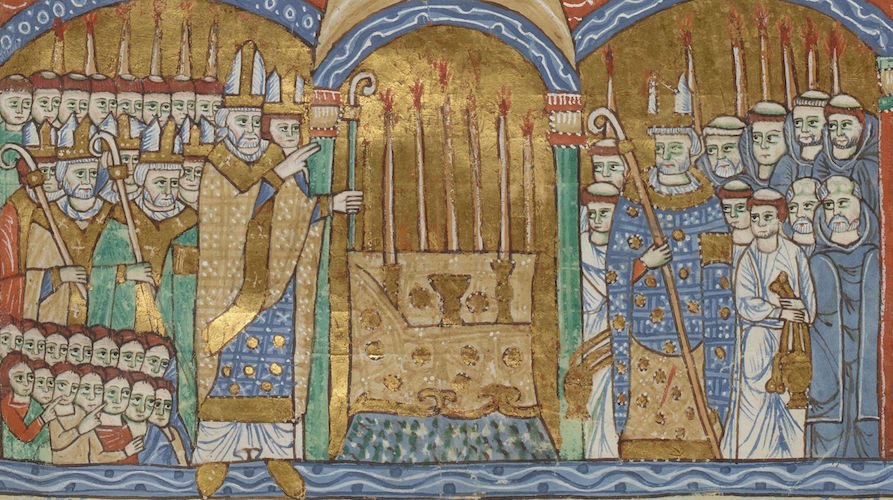
The largest church in Christendom
The abbey of Cluny III (located in Southern Burgundy, France) started modestly enough—the first church being a relatively simple barn like structure. However, Cluny quickly grew to be home to the largest church in Christendom—a title it would hold for over 200 years.
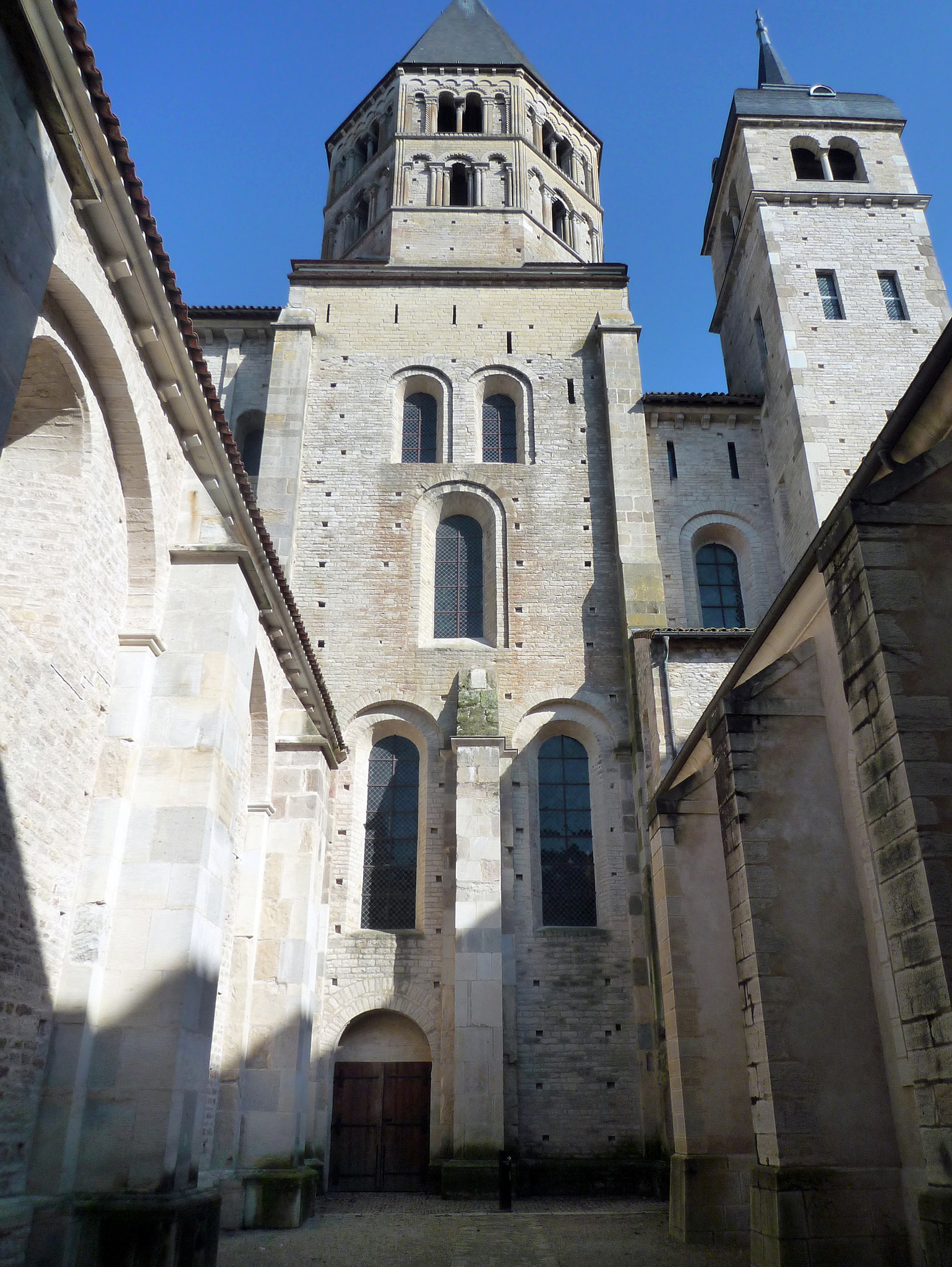
But first things first, what exactly is an abbey? An abbey can refer to a Christian church, but the term generally goes beyond that to refer to the grouping of buildings that constitutes the housing and other necessary buildings for a society of Christian monks or nuns who were all living under a specific religious rule (the rule regulated their lives, specifying behavior and the organization of the monastery). In the case of Cluny, the rule the monks lived under was that of Saint Benedict of Nursia, who had, in the 6th century, advocated a life divided between prayer, rest, study, and work.
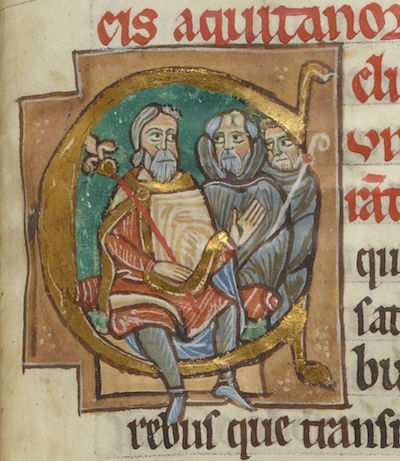
A gift from William I, Duke of Aquitaine
The site of abbey originally belonged to William I, Duke of Aquitaine and was home to his favorite hunting box (a hunting lodge for use during the hunting season). In the Middle Ages, a duke (the highest ranking member of the nobility) often wielded much more power and authority than a king (this was in part because the dukes held sway over the provinces, and power was decentralized). Dukes were often wealthier than the king (as the Très Riches Heures of the Duke of Berry demonstrates). While a hunting box may conjure up visions of a one-room cabin, likely it was a large and stately home in its own right—so when, toward the end of his life, William I gave up the home, lands, and hunting rights (and several other parcels of land as well), so that charitable institutions could be built, it was a significant donation. The land that would become Cluny was placed into the hands of a venerable monk named Berno, who would become Saint Berno of Cluny.
Cluny I
Berno was the abbot of the newly founded Cluny from 910 to 925. The monastery was created to be a reform order that strictly adhered to the Rule of Saint Benedict.* Cluny sought to reform monastic life by returning to the Western monastic traditions of previous centuries which focused on peace, solitude, prayer, and work (such as caring for the poor). Importantly, William I of Acquataine (sometimes referred to as William the Pious), endowed the abbey with something more than land—he gave it independence. As a result, the abbey answered directly to the pope and did not have to obey any other dictates, or taxation, from local lords. This would help Cluny to become a wealthy center of the arts.

The first abbey at Cluny (Cluny I, which no longer exists aside from archaeological remains) developed quickly—becoming akin to small town, boasting over 200 monks. It was laid out in the style of the Saint Gall Plan—a large-scale architectural drawing of the “ideal” abbey that was created in Switzerland around 800 C.E. (above and annotated plan here). To our knowledge, no such abbey ever actually existed, but many abbeys appear to have been modeled on the plan—Cluny being one of them. The cloister (a quadrangular walkway where monks would stroll in meditation), is generally regarded as the spiritual center of an abbey. The Saint Gall plan places it literally in the center, and the other buildings, for example, workshops, domestic quarters, etc., surround it.
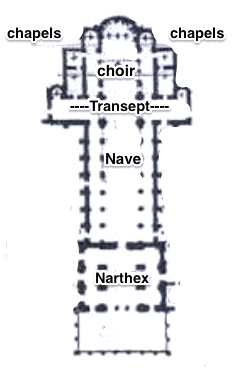
Cluny II
As mentioned, the first church at Cluny was likely not much more than a simple place of worship. However, as the order prospered, something larger and more illustrious was called for. Soon after the passing of Berno, a monk named Odo took over as his successor and continued to expand the abbey. The second incarnation of the church at Cluny (Cluny II) was begun just decades after the first.
What we know of it is largely speculative—based on written records and excavations. This second iteration (plan, left) sported a narthex (an enclosed area at the entrance of a church) with two towers in the west, a choir (the area between the main body of church and the altar) with a tower and chapels in the east, in addition to the main basilica form (a basilica is a church plan consisting of a rectangular space, often divided into the central area, or nave, with aisles on either side). The choir had chapels in echelon, or stepped out one after the other—one of the first examples of an architectural form that would become extremely popular. It also had a projecting transept (which cuts perpendicularly across the main body of the basilica).
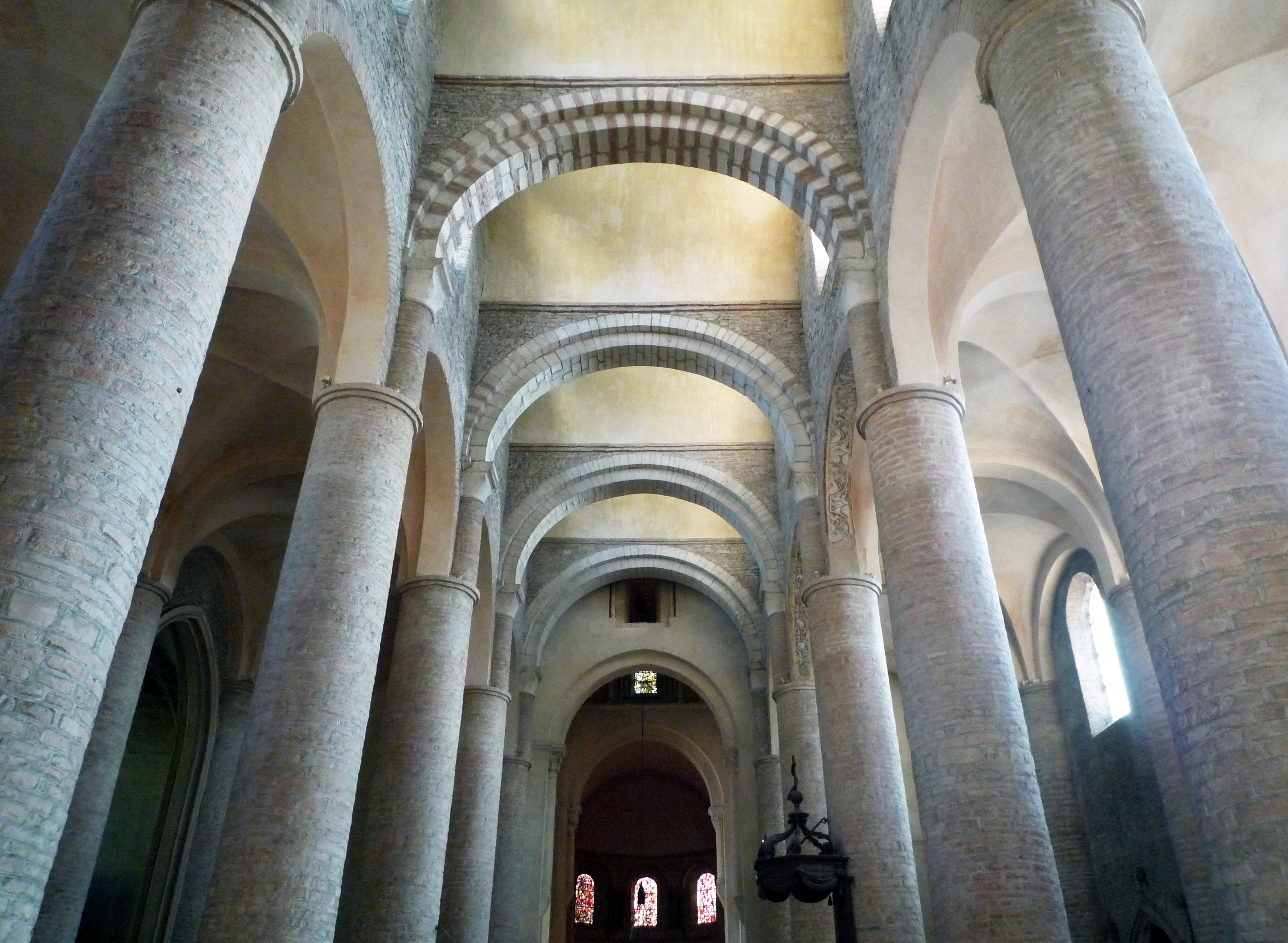
The church consisted of an illuminated barrel vault, not unlike that still in existence at Saint Philibert at Tournus, Cluny’s neighbor (above). That abbey, and a few others in Burgundy, had been experimenting with the barrel vault. It is good to remember that the work of these builders was largely trial and error. From what we are given to understand, this was very much in keeping with the Romanesque style of the region. As Cluny I and II no longer exist, much of what we have to go on comes from extensive excavation studies—particularly those done by Kenneth Conant.
Romanesque architecture is known for its regional styles—the look and feel of Romanesque churches could vary widely from region to region. Burgundy and the pilgrimage churches were particularly important influences on the style that would develop into Gothic. Gothic architecture began to take on a more “International,” style, sharing characteristics from region to region where Romanesque churches varied largely depending on their location and the local building practices. The only thing that almost all Romanesque churches shared was the use of the rounded stone barrel vault. The nature of a barrel vault, which exerts continual lateral pressure, is not conducive to piercing the supporting walls with windows, so barrel vaulted structures tend to be poorly lit. At Tournus—and likely Cluny II—the builders tried to circumvent this by placing small windows above the arcade. This was the first example of an illuminated vaulted church.
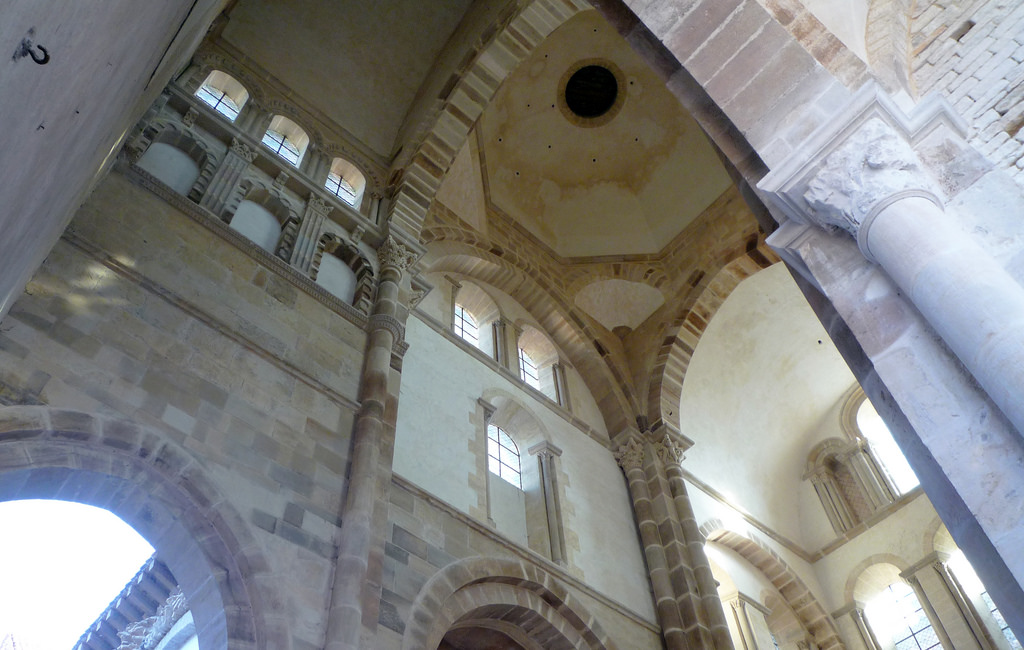
Cluny III
Cluny had a series of strong abbots, and Hugh of Semur was one of that line. He waited until he had been in that position for 40 years before beginning construction on the monumental project that would be Cluny III. It is thought he was intent on observing the latest trends—seeing what worked and what didn’t—before embarking on this great building project. Cluny III seems to have been built with the idea of plucking the best attributes from what had been created before and synthesizing them into a grandiose structure worthy of the prestigious order. It was not completed until 1130 (Hugh the Great died in 1109,) and when it was complete it stood as the largest in Europe—with five aisles (rivalling Old Saint Peter’s in Rome).
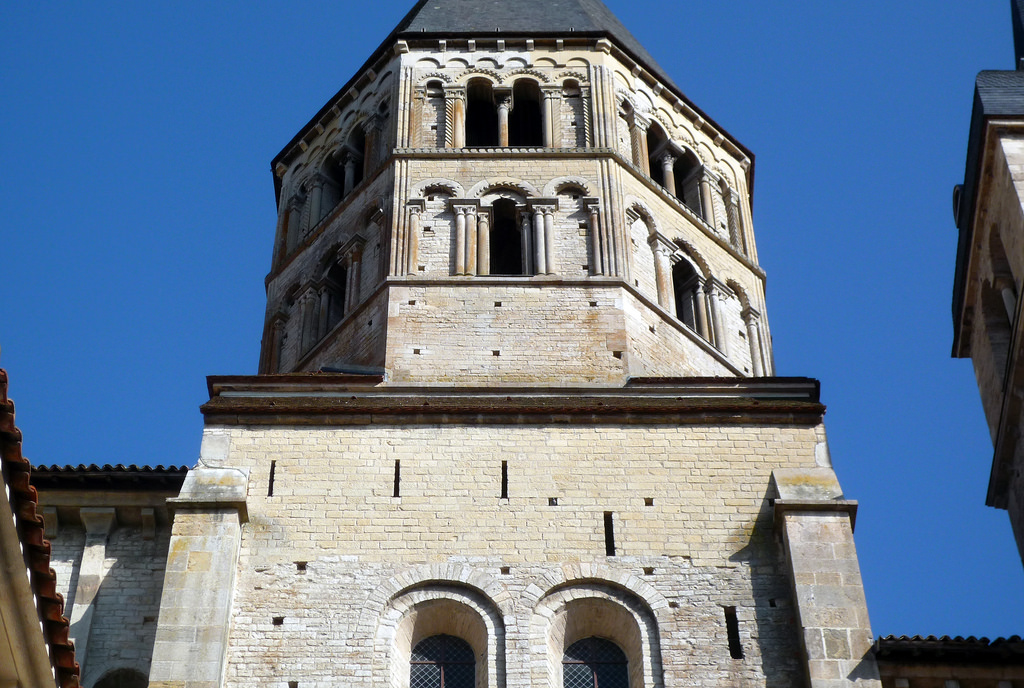
The structure was built from a combination of brick and ashlar (stone) which had hitherto been part of two separate traditions. In many ways, the church laid out was the same as its popular Pilgrimage Route cousins. In addition to the spacious basilica with five aisles, it had two transepts, an ambulatory, and radiating chapels at the east end. The crossings were surmounted by octagonal towers (above) with additional towers over the transept arms. Only a singular transept arm still survives today (top of page).
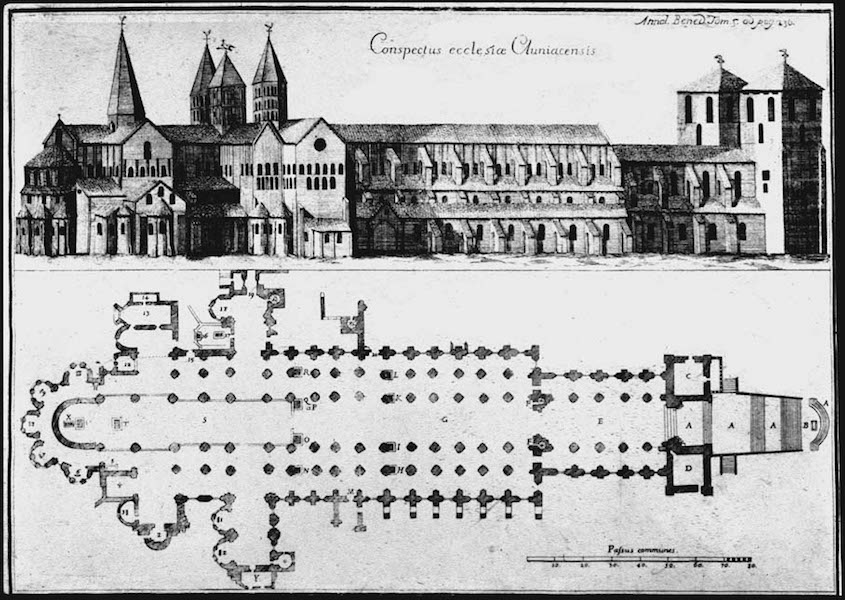
While only the foundation and some other bits and pieces remain, scholars have reconstructed what the interior would have looked like as well (below). Composed of a three story elevation consisting of slim aisles with pointed arches, blind arcade with three arches in each bay and a triple clerestory, it would have been a sight to behold. The slightly pointed dome rose to a height of 98 feet. This vaunting ambition may have helped lead to the partial collapse in 1125—though quickly repaired by the time consecration took place in 1130.
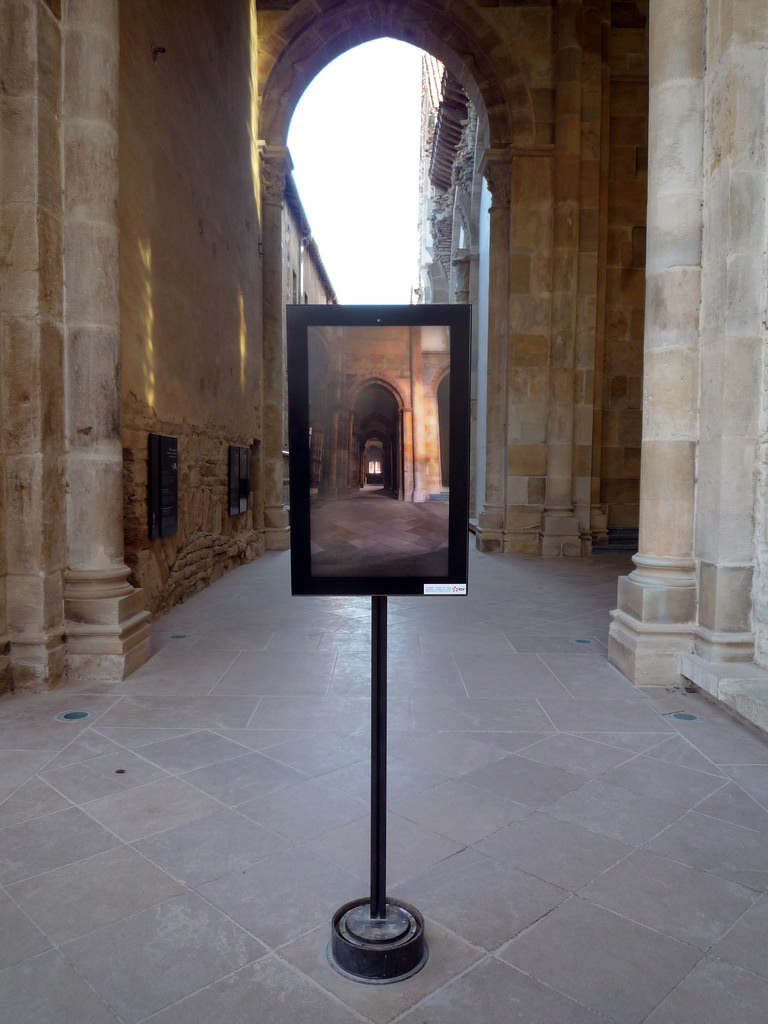
In many ways Cluny III followed, at least in plan, that of a colossal pilgrimage church and there are those who speculate that in fact Cluny was intent upon trying to compete with those medieval moneymakers. The abbey was in fact paid for in large part by money seized from Spanish Muslims who had been conquered by their Christian counterparts.
While William would help found many other monasteries, none would be so prosperous as Cluny. At its height Cluniac congregations numbered at over 1000. Berno was actually given the power to be the abbot of many abbeys, not just Cluny, and his successor, Odo, also began to gather more abbeys under Cluny’s rule. As one might imagine, this idea was not popular given these other abbeys were used to their own systems of rule. But the situation did help expand Cluny into the powerful institution it would become; it would be from Cluny that a number of Popes would be plucked. However, despite the Cluniac movement being a reform movement itself, by late 11th century another breakaway group had formed—the Cistercian movement and, like Cluny, it would be highly successful (see article on Fontenay.) At the time of the Cistercian schism, the Cluniac order was suffering from corruption and excess (too much interest in things of the material world). A far cry from its devout beginnings!
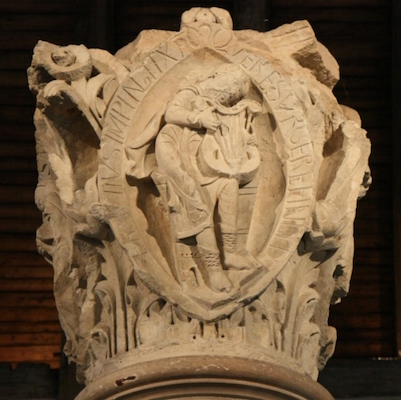
*The foundation of the physical church of Cluny was the beginning of the Cluniac, or Benedictine Reforms. Theoretically, all Roman Catholic monks were meant to follow three simple rules set out hundreds of years earlier by Saint Benedict of Nursia. Essentially these precepts could be boiled down to peace, prayer and work. Cluniac monks also observed the traditional eight Benedictine hours of the Divine office: Matins, Lauds, Prime, Terce, Sext, None, Vespers, and Compline. Some of the most delightful (and still intact), artwork of Cluny III are the capitals representing the tones of the Gregorian chant, or plainsong. Rescued from the rubble of the choir, these marvelous sculptures show tones of the chant personified as small figures standing in their concave almond-shaped mandorlas. Some of the figures are playing instruments, some seem to be contorted into movements of a dance.
Smarthistory images for teaching and learning:
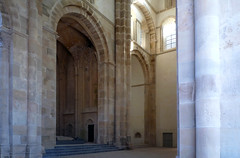
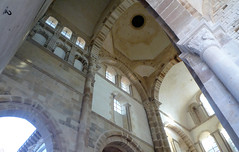
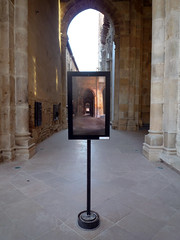

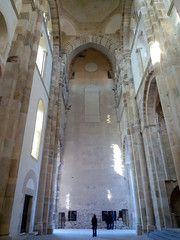
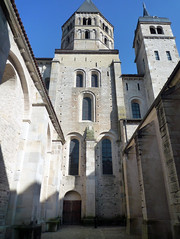
Saint-Pierre, Moissac
by DR. SHANNON PRITCHARD

The church of Ste. Pierre (St. Peter) in Moissac, France, dating from 1115-30, has one of the most impressive and elaborate Romanesque portals of the twelfth century. Carved images occupy the walls of the extended porch leading to the door, the door itself, and even the space over the door.
Pilgrimage routes
The church of Ste. Pierre was on one of the pilgrimage roads through France that led to Santiago de Campostela, in Spain. As it was home to the remains of St. James Major, that Spanish church was one of the most important pilgrimage sites in Western Europe. Ste. Pierre in Moissac was a popular stop for those making the long and arduous journey to Spain.


In order to understand what is depicted on the main areas surrounding the portal that leads into the church, let’s break it down into its constituent parts. The term portal refers to a doorway or entry into a building, and Romanesque portals have distinct architectural elements which were oftentimes carved with a variety of ornament and subject matter.
In the case of Ste. Pierre, the portal is divided in half vertically by the trumeau, which is decorated on three of its four sides. On the front, the viewer is faced with three pairs of intertwined lions and lionesses who are there to symbolically guard the entry into the sacred space of the church. Such symbolism comes from Early Christian imagery where the doors to Christ’s tomb are often shown with lion’s heads on them. On the east side of the trumeau is a representation of the Old Testament prophet Jeremiah (some scholars suggest it is Isaiah), who holds a scroll in his hands. On the west side is a figure identified as St. Paul, from the New Testament.
The placement of these two figures on the sides of the trumeau was no doubt deliberate as they face two other figures on the door jambs (the outer walls of the portal where the doors are attached). Across from St. Paul is a representation of St. Peter, also a New Testament saint (and the namesake of the church), and across from Jeremiah, is the Old Testament prophet Isaiah. The pairing of Old and New Testament figures was common during this period as a means of suggesting the fulfillment of Mosaic law (the law coming Moses) in the new Christian law under Christ.

The trumeau has more than just a decorative function though as it is also supports the horizontal beam of stone above called the lintel. The lintel is decorated with ten rosettes that are bound together by a carved rope and have a repeated floral pattern at both the upper and lower spaces between each rosette. Notice that on both the left and right ends of the lintel, the rope and rosette design is coming from the mouth of a fantastical animal of some sort (image, above)! Details such as these, with imaginative, hybrid animals are a common characteristic in Romanesque art from illuminated manuscripts to sculpture.

Just above the lintel is the lunette-shaped (semi-circular) tympanum, which has the majority of the sculpted decoration (and this is true in most Romanesque and Gothic portals). In this case, the tympanum is surrounded by three decorative archivolts (arches), which have various foliate patterns carved into the individual blocks of stone, known as the voussoirs, which make them up.

During the Romanesque and Gothic periods, there were two subjects which were popular for tympanum decoration. One was the subject of the Last Judgment, when Christ sits as judge over those who will be divided into the Saved and the Damned. An example of this can be seen at Autun.
The other oft-represented subject is known as the Maiestas Domini (Christ in Majesty), and here at Moissac we are presented with a very literal depiction of a passage from the Book of Revelation (4:2–7), which reads:
And immediately I was in the Spirit, and behold a throne was set in heaven, and one sat on the throne…And round the throne were four and twenty seats; and upon the seats I saw four and twenty elders sitting, clothed in white raiment; and they had on their heads crowns of gold…And before the throne there was a sea of glass like unto a crystal; and in the midst of the throne, and round about the throne, were four beasts…And the first beast was like a lion, and the second beast like a calf, and third beast had a face as a man, and the fourth beast was like a flying eagle.
The moment described in this passage, and represented here, is not a narrative in the sense that the Last Judgment is, but it is rather a more esoteric concept of the Second Coming of Christ and the End of Time.

In the very center of the composition is the figure of Christ, seated on a throne, with his right hand raised in gesture of blessing. In his left hand he balances a book on his knee, perhaps a reference to the Book of Revelation. His circular halo is inscribed with a cross (known as a cruciform halo), and we can just make out the suggestion of a larger, almond-shaped body halo (called a “mandorla” after the Italian word for almond) just visible as the pointed arch behind Christ’s haloed head.
Immediately to the left and right of the seated figure of Christ are the Evangelical Beasts, three animals and one human figure, who represent the four Evangelists who wrote the New Testament Gospels. Matthew, in the upper left, is represented by the winged man, Mark just below is shown as the lion, Luke on the bottom right is seen as the ox, and John the Evangelist is represented as the eagle. The representation of the four Evangelists as a tetramorph was common in sculpture, painting, and illuminated manuscripts.

On either side of the Evangelical Beasts are two tall, elegant angels holding scrolls, as well as the twenty-four elders mentioned in the text from Revelations. They are arranged on three levels, two of which are divided by wavy lines, reminding us of the “sea of glass.” Each elder holds a small musical instrument in one hand and a chalice in the other (some of these have broken off over time). Very clearly all of the figures—man and beast—are turned toward the central figure of Christ, who stares serenely out toward the viewer. The twenty-four elders crane their necks and twist their bodies as do the Evangelical beasts. Even the lines of the drapery seem to be directing our attention toward the center.

A brief comparison between the style of the sculptures in this tympanum and that employed on the Early Gothic portal of Chartres Cathedral (above), which is also a Maiestas Domini, clearly illustrates the very lively, almost agitated sense of the figures at Moissac. At Chartres, the twenty-four elders are now the voussoirs in the archivolts and the figure of Christ, seated frontally and surrounded by the mandorla, is flanked by the four evangelical beasts. Here, however, is a sense of clarity and three-dimensionality that is markedly different from the style seen at Moissac.
And as the road weary pilgrims would have approached the portal of the church Saint-Pierre, they were met with spectacular imagery that warned against sin, and reminded them of Christ’s sacrifice and his final coming. The portal at Moissac would have been a veritable feast for the Romanesque viewer’s eyes and souls.
Additional resoures:
Last Judgment, Tympanum, Cathedral of St. Lazare, Autun (France)
by DR. STEVEN ZUCKER and DR. BETH HARRIS
Video \(\PageIndex{2}\): Last Judgment, Tympanum, Central Portal on West facade of the Cathedral of St. Lazare, Autun (France), c. 1130-46
Smarthistory images for teaching and learning:
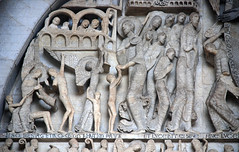
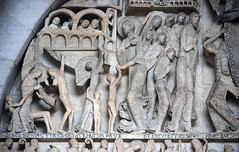
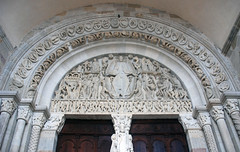
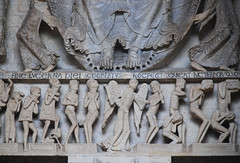
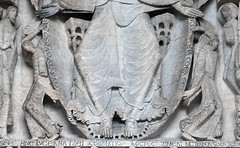
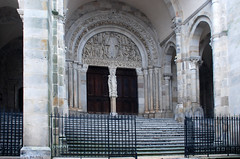
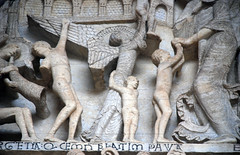
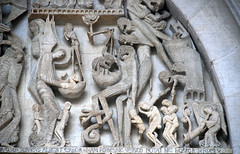
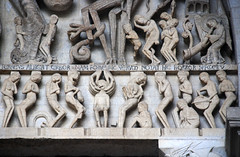
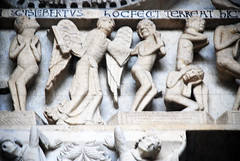

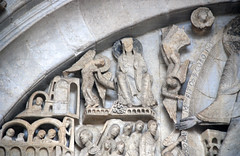
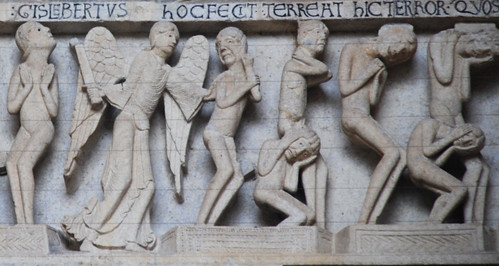
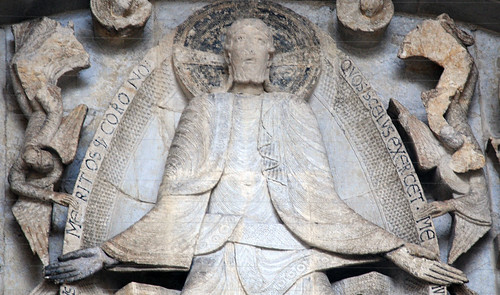
Church and Reliquary of Sainte-Foy, France
On the road
Imagine you pack up your belongings in a sack, tie on your cloak, and start off on a months-long journey through treacherous mountains, unpredictable weather and unknown lands. For the medieval pilgrim, life was a spiritual journey. Why did people in the Middle Ages take pilgrimages? There are many reasons, but visiting a holy site meant being closer to God. And if you were closer to God in this life, you would also be closer to God in the next.
A Romanesque pilgrimage church: Saint-Foy, Conques

Located in Conques, the Church of Saint-Foy (Saint Faith) is an important pilgrimage church on the route to Santiago de Compostela in Northern Spain. It is also an abbey, meaning that the church was part of a monastery where monks lived, prayed and worked. Only small parts of the monastery have survived but the church remains largely intact. Although smaller churches stood on the site from the seventh century, the Church of Saint-Foy was begun in the eleventh century and completed in the mid-twelfth century. As a Romanesque church, it has a barrel-vaulted nave lined with arches on the interior.

It is known as a pilgrimage church because many of the large churches along the route to Santiago de Compostela took a similar shape. The main feature of these churches was the cruciform plan. Not only did this plan take the symbolic form of the cross but it also helped control the crowds of pilgrims. In most cases, pilgrims could enter the western portal and then circulate around the church towards the apse at the eastern end. The apse usually contained smaller chapels, known as radiating chapels, where pilgrims could visit saint’s shrines, especially the sanctuary of Saint Foy. They could then circulate around the ambulatory and out the transept, or crossing. This design helped to regulate the flow of traffic throughout the church although the intention and effective use of this design has been debated.

A warning in stone: The tympanum of the Last Judgment

When a pilgrim arrived at Conques, they would probably head for the church to receive blessing. Yet before they got inside, an important message awaited them on the portals: the Last Judgment. This scene is depicted on the tympanum, the central semi-circular relief carving above the central portal.
In the center sits Christ as Judge, and he means business! He sits enthroned with his right hand pointing upwards to the saved while his left hand gestures down to the damned. This scene would have served as a reminder to those entering the Church of Saint-Foy about the joys of heaven and torments of hell. Immediately on Christ’s right are Mary, Peter and possibly the founder of the monastery as well as an entourage of other saints.

Below these saints, a small arcade is covered by a pediment, meant to represent the House of Paradise. These are the blessed, those have been saved by Christ and who will remain in Paradise with him for eternity. At the center, we find Abraham and above him notice the outstretched hand of God, who beckons a kneeling Saint Faith (see image below).

On the other side of the pediment, a row of angels opens the graves of the dead. As the dead rise from their tombs, their souls will be weighed and they will be admitted to heaven or hell. This is the scene that we see right under Christ’s feet—you can see the clear division between a large doorway leading to Paradise and a terrifying mouth that leads the way to Hell.

Inside Hell, things aren’t looking very good. It is a chaotic, disorderly scene—notice how different it looks from the right-hand side of the tympanum. There is also a small pediment in the lower register of Hell, where the Devil, just opposite to Abraham, reigns over his terrifying kingdom.


The devil, like Christ, is also an enthroned judge, determining the punishments that await the damned according to the severity of their sins. In particular, to the devil’s left is a hanged man. This man is a reference to Judas, who hanged himself after betraying Christ. Just beyond Judas, a knight is tossed into the fires of Hell and above him, a gluttonous man is hung by his legs for his sins. Each of these sinners represents a type of sin to avoid, from adultery, to arrogance, even to the misuse of church offices. Indeed, this portal was not only a warning for pilgrims, but for the clergy who lived in Conques as well.
The reliquary

Pilgrims arriving in Conques had one thing on their mind: the reliquary of Saint Foy. This reliquary, or container holding the remains of a saint or holy person, was one of the most famous in all of Europe. So famous that it was originally located in a monastery in Agen but the monks at Conques plotted to steal it in order to attract more wealth and visitors. The reliquary at Conques held the remains of Saint Foy, a young Christian convert living in Roman-occupied France during the second century. At the age of twelve, she was condemned to die for her refusal to sacrifice to pagan gods, she is therefore revered as a martyr, as someone who dies for their faith. Saint Foy was a very popular saint in Southern France and her relic was extremely important to the church; bringing pilgrims and wealth to the small, isolated town of Conques.

While the date of the reliquary is unknown, Bernard of Angers first spoke it about in 1010. At first, Bernard was frightened that the statue was too beautiful stating, “Brother, what do you think of this idol? Would Jupiter or Mars consider himself unworthy of such a statue?” He was concerned about idolatry—that pilgrims would begin to worship the jewel-encrusted reliquary rather than what that reliquary contained and represented, the holy figure of Saint Foy. Indeed, the gold and gem encrusted statue would been quite a sight for the pilgrims. Over time, travelers paid homage to Saint Foy by donating gemstones for the reliquary so that her dress is covered with agates, amethysts, crystals, carnelians, emeralds, garnets, hematite, jade, onyx, opals, pearls, rubies, sapphires, topazes, antique cameos and intaglios. Her face, which stares boldly at the viewer, is thought to have originally been the head of a Roman statue of a child. The reuse of older materials in new forms of art is known as spolia. Using spolia was not only practical but it made the object more important by associating it with the past riches of the Roman Empire.
The Church of Saint Foy at Conques provides an excellent example of Romanesque art and architecture. Although the monastery no longer survives, the church and treasury stand as a reminder of the rituals of medieval faith, especially for pilgrims. Even today, people make the long trek to Conques to pay respect to Saint Foy. Every October, a great celebration and procession is held for Saint Foy, continuing a medieval tradition into present day devotion.
Additional resources:
Sainte-Foy at Conques on Mapping Gothic France (Columbia University)
Gigapixel image of the Tympanum on Mapping Gothic France (Columbia University)
Toman, Rolf, and Achim Bednorz, Romanesque: architecture, sculpture, painting (Köln: Könemann, 1997).
Pamela Sheingorn, Robert L. A. Clark, and Bernardus, The Book of Sainte Foy (Philadelphia: University of Pennsylvania Press, 1995).
Janetta Rebold Benton, Art of the Middle Ages (New York, N.Y.: Thames & Hudson, 2002).
Pentecost and Mission to the Apostles Tympanum, Basilica Ste-Madeleine, Vézelay (France)
by DR. BETH HARRIS and DR. STEVEN ZUCKER
Video \(\PageIndex{3}\): Pentecost and Mission to the Apostles Tympanum, central portal of the narthex, Basilica Ste-Madeleine, Vézelay (France), 1120-32
Basilica of Saint-Sernin
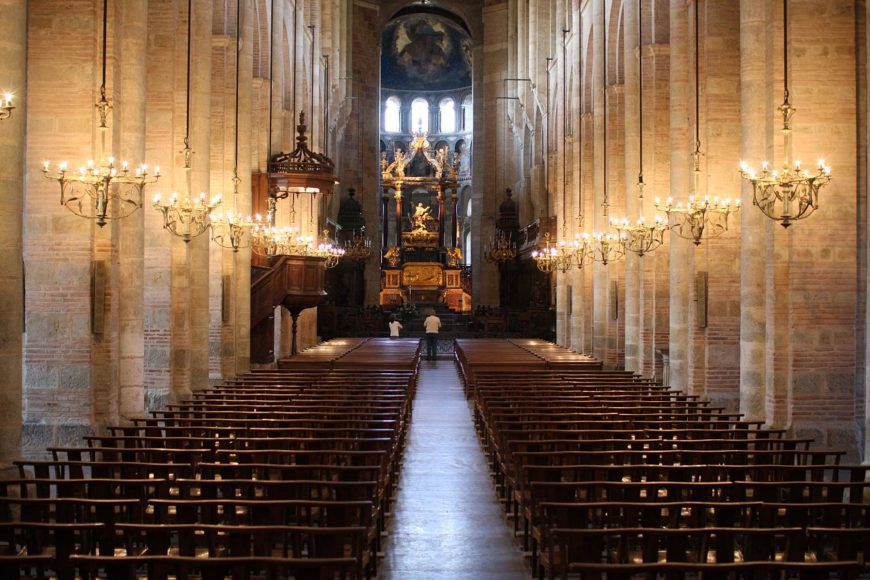
The political center of Toulouse, France today is Place du Capitole, an open city square to the east of a beautiful eighteenth-century neoclassical building. Two major north-south roads traverse the western side of this square, and the names of these two thoroughfares have much to say about the history of the city. The street on the southern end of the square — Rue de Sainte-Rome — is named after a long since destroyed thirteenth-century Dominican church, Sainte-Romain. The street that proceeds northwards from the northwest corner of Place du Capitole — Rue du Taur — whispers the smallest of hints as to the most important church in the city, Saint-Sernin.
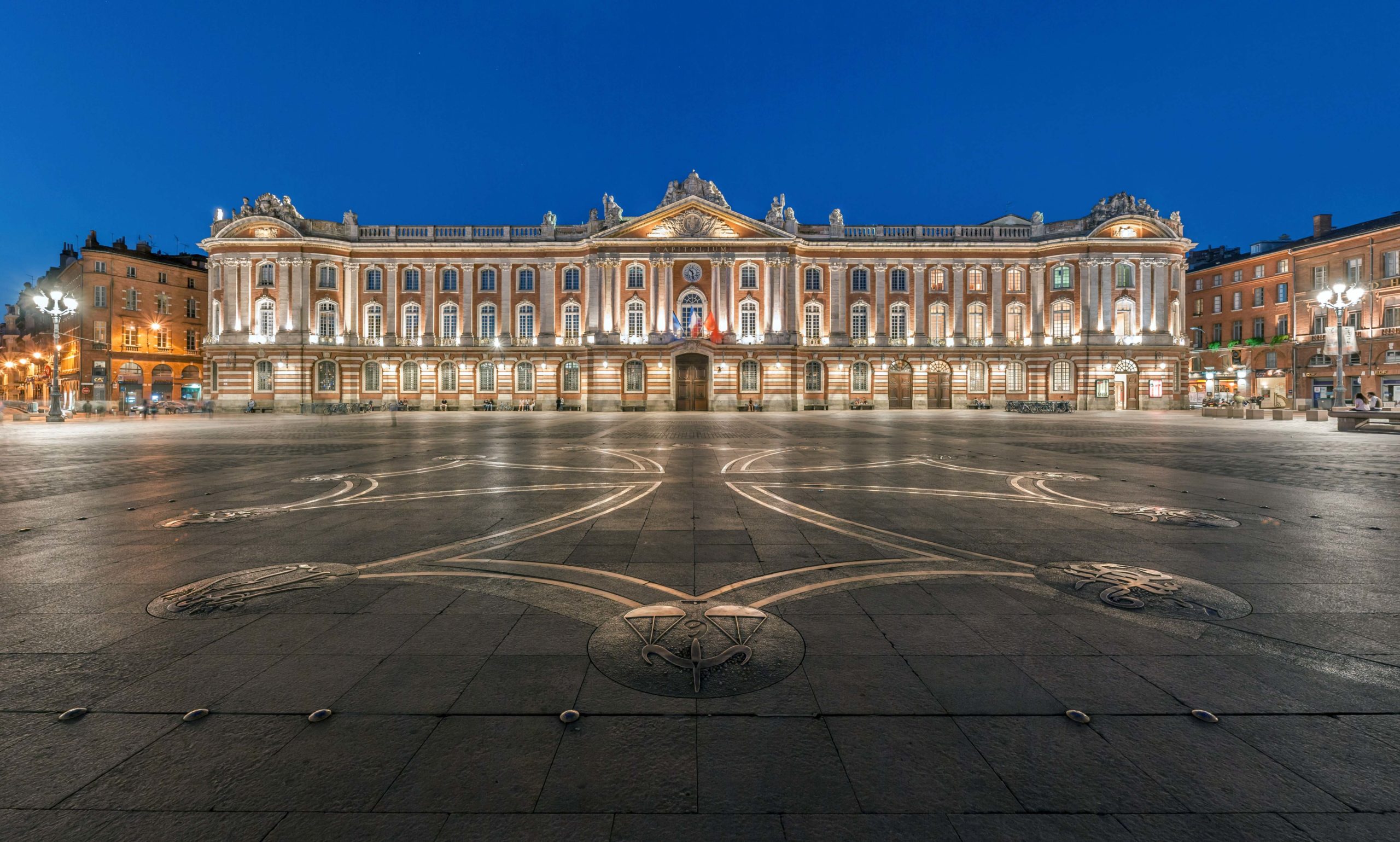
A martyred saint
This imposing Romanesque basilica was constructed in honor of St. Sernin (Saturninus in Latin), the first bishop of Toulouse. He was born in the early third century in Greece, and was one of seven bishops that Pope Fabian sent to different parts of Gaul to actively preach the Christian gospels to the pagans who lived in those areas. Many stories that pertain to the early Christian martyrs are fantastical, and we should take Sernin’s own narrative with the proverbial grain of salt.
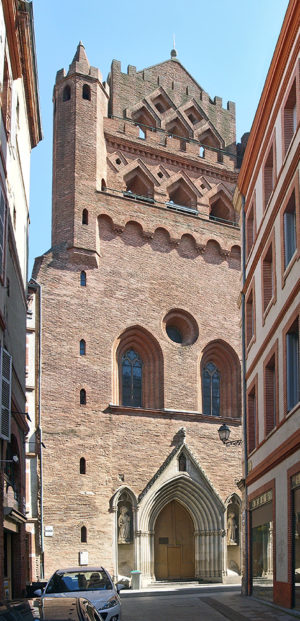
According to legend, when Sernin entered the city of Toulouse, all of the pagan idols — which hitherto had regularly spoken to their priests — suddenly and disturbingly fell into silence. One day in 257, a great group had gathered around an altar, and a man pointed to Sernin as the cause of this divine silence, exclaiming, “There is the one who preaches everywhere that our temples must be torn down, and who dares to call our gods devils! It is his presence that imposes silence on our oracles!” Sernin was then chained to a nearby bull and drug through the city until his body was broken and skull crushed. His corpse was eventually deposited on a street that since those times has been called the Rue du Taur, the Road of the Bull. A church appropriately called Notre Dame du Taur commemorates the spot where the bull finally deposited the lifeless body. About 300 meters further north is Saint-Sernin, the basilica where the martyred saint’s bodily remains are purported to reside.
A pilgrimage church
Begun sometime around 1080 (approximately 825 years after the saint’s death), Saint-Sernin was formally consecrated as a church about a century later. The opening centuries of the second millennium were a time of great religious pilgrimages, and one of the most important pilgrimage sites for the Catholic faithful — then as now — is the cathedral of St. James in Santiago de Compostela, a city in northern Spain. For the pilgrims commencing their journey in Italy, the path they travelled took them through the southern part of France, and one of the major stopping points on this section of the Santiago Trail — the Way of St. James — was the city of Toulouse and the basilica of Saint-Sernin, the church that held the relics of one of the most famous martyred saints of the area.
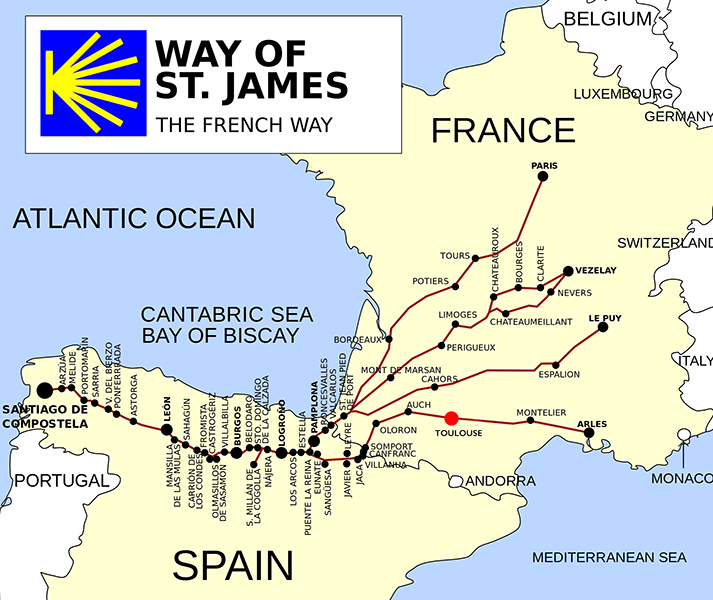
Saint-Sernin is an excellent example of a Romanesque pilgrimage church, a building that needed to accomplish two interrelated ends. First, the structure needed to provide a suitably inspiring shrine for the holy relics of the saint it was built to commemorate. Second, it needed to be large enough to accommodate the thousands of pilgrims who would arrive each day to pray before and venerate those relics. Fulfilling these two goals, Saint-Sernin is one of the best-preserved and perhaps the largest Romanesque churches in the world. Even almost 950 years after its construction was begun, it remains a religious structure that awes and inspires the pilgrims who still visit.
The Romanesque style is so called because the medieval architects who designed these buildings used a fundamentally Roman architectural language. Romanesque churches are notable for their thick walls with relatively few windows, Roman arches, barrel vaults, and the use of massive vaulting. In contract to the Gothic buildings that would become fashionable a couple of centuries later, Romanesque churches appear heavy and comparatively dark. Saint-Sernin is also an excellent example of a church with a Latin cross plan. A long central east-west nave is intersected by a shorter north-south transept, a shape that mimics the most recognizable symbol of the Christian faith.
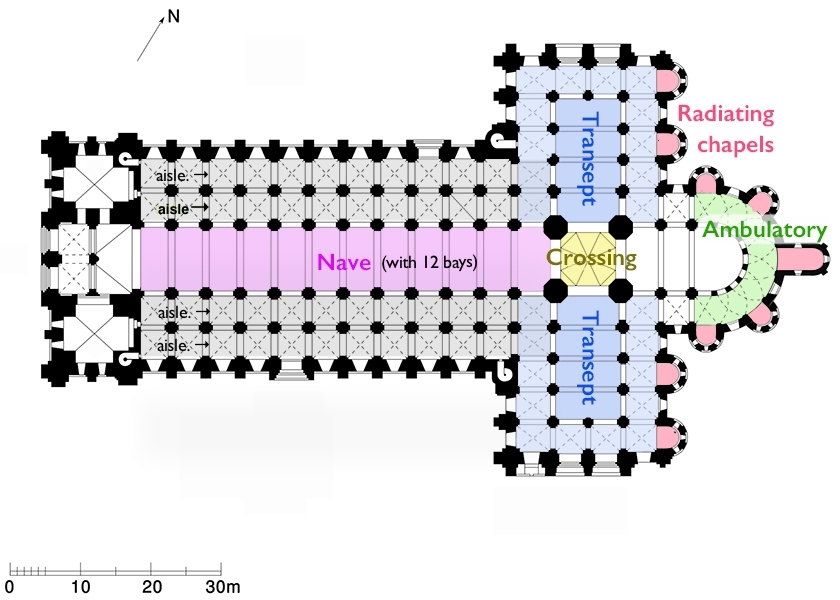
One of the best ways to fully appreciate a medieval church is to stroll around its exterior. Indeed, during this circumnavigation, one is not only transported back in time, but also through time. It often took centuries to construct churches of the size and scale of Saint-Sernin. By walking around the exterior of these churches an observant visitor can clearly see shifting architectural styles and changing sculptural aesthetics. Although construction was begun on Saint-Sernin by about 1080, slight changes in the proportion of brick and stone used during the course of its construction suggest the church went through a number of different building campaigns from its genesis until its ultimate conclusion, perhaps as many as four. Romanesque (and Gothic) churches are often a negotiation between what was dreamed and what came to pass; the final church often looks different from its original architectural plan.
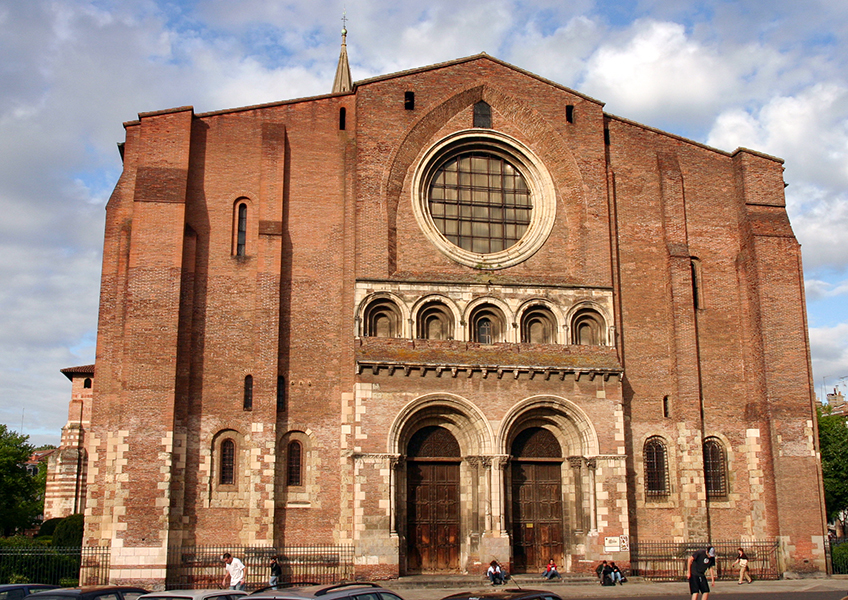
This is evident when looking at the west façade of the church (in medieval churches, this is commonly referred to as the westwork). Most churches during the late medieval period were constructed with a tower on both the north and south ends of the westwork, and the extensive and massive buttressing on the corners of the west façade of the structure strongly indicate that such towers were part of the original plan of the church. In the absence of these vertical towers, the front of the church is instead dominated by its large central circular window, set into a shallow pointed arch recession. Underneath this window are five small Roman (round) arches that harmoniously frame the two large Roman arch entranceways. This central part of the façade — from the large entrances to the circular window — is framed by the vertical buttresses on the left and right sides.
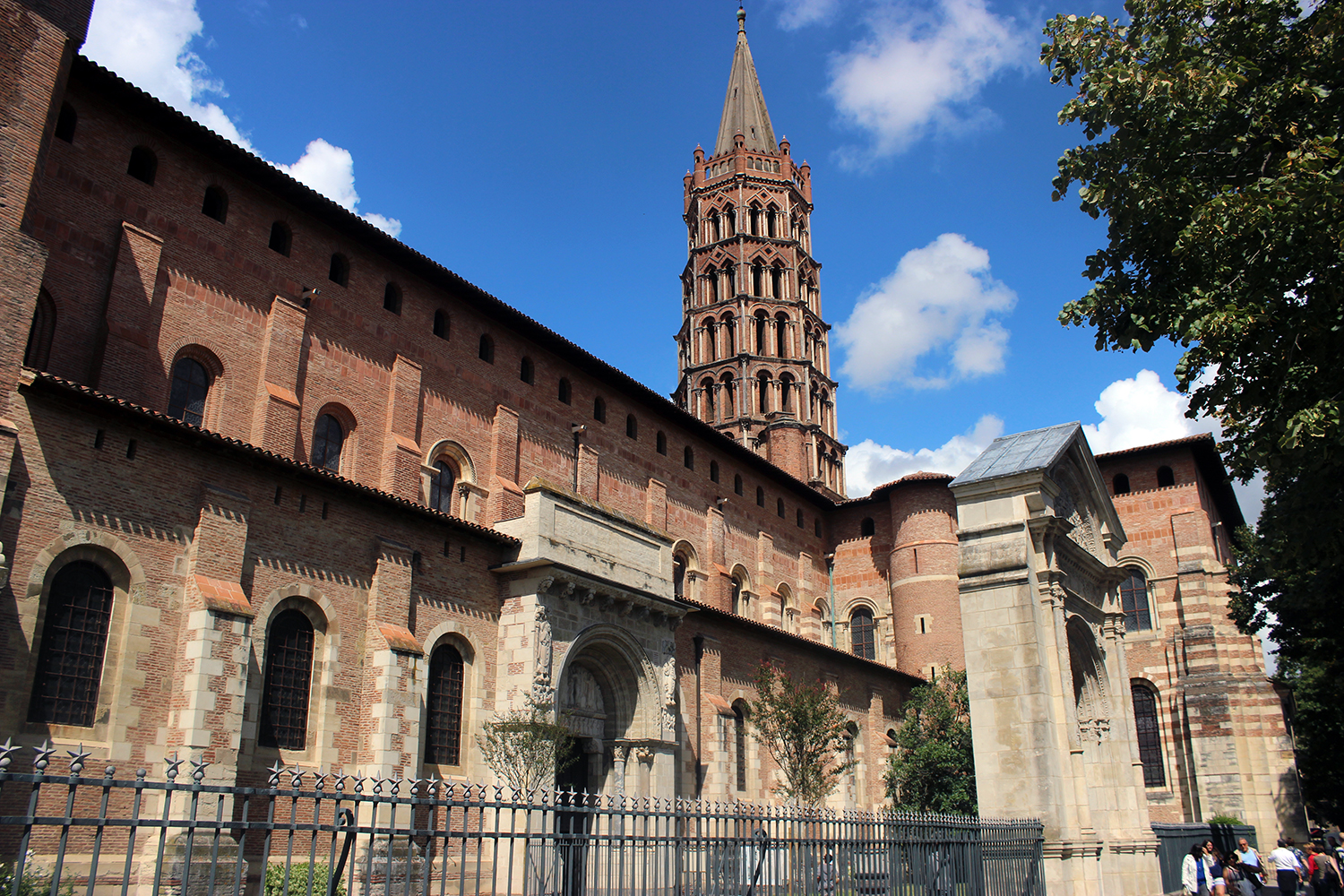
Walking from the front of the church along one of the sides brings into focus the large bell tower over the crossing. The octagonal tower is made of five layered tiers that are capped by a spire. The first three tiers feature Roman arches and were likely begun in the twelfth century. The much later uppermost tiers date from about 1270 — nearly two centuries after construction the church first began — and feature Gothic pointed arches. The spire at the top was finally completed around 1470 and measures 213 feet (65 m) in height. The bell tower alone is a visual lesson in the shifting architectural styles in fashion over the four centuries of a church’s construction.
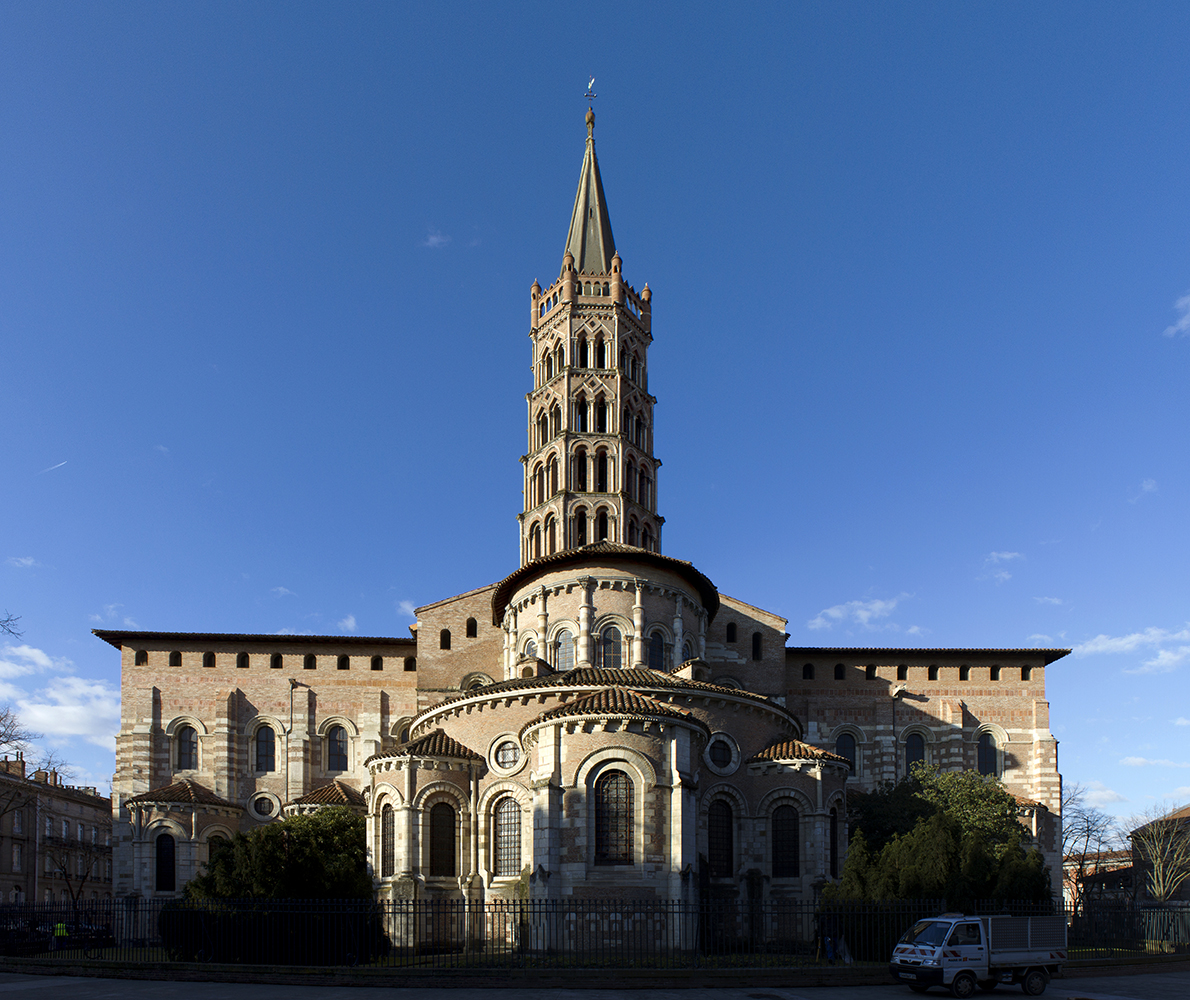
If the bell tower and its spire are the elements of the church that are most visible around the city of Toulouse, it is the architectural elements on the eastern side of the church — the apse end — that made Saint-Sernin famous. It was common during the medieval era for the apse of the church to have small chapels for the placement of holy relics where pilgrims could come to visit and venerate them. But in Saint-Sernin, the entire eastern end of the church — from the north transept, around the apse, and concluding on the southern transept — is filled with nine radiating chapels. Even from an exterior view, it is clear that one of the primary roles of this structure was to house relics for pilgrims to visit.
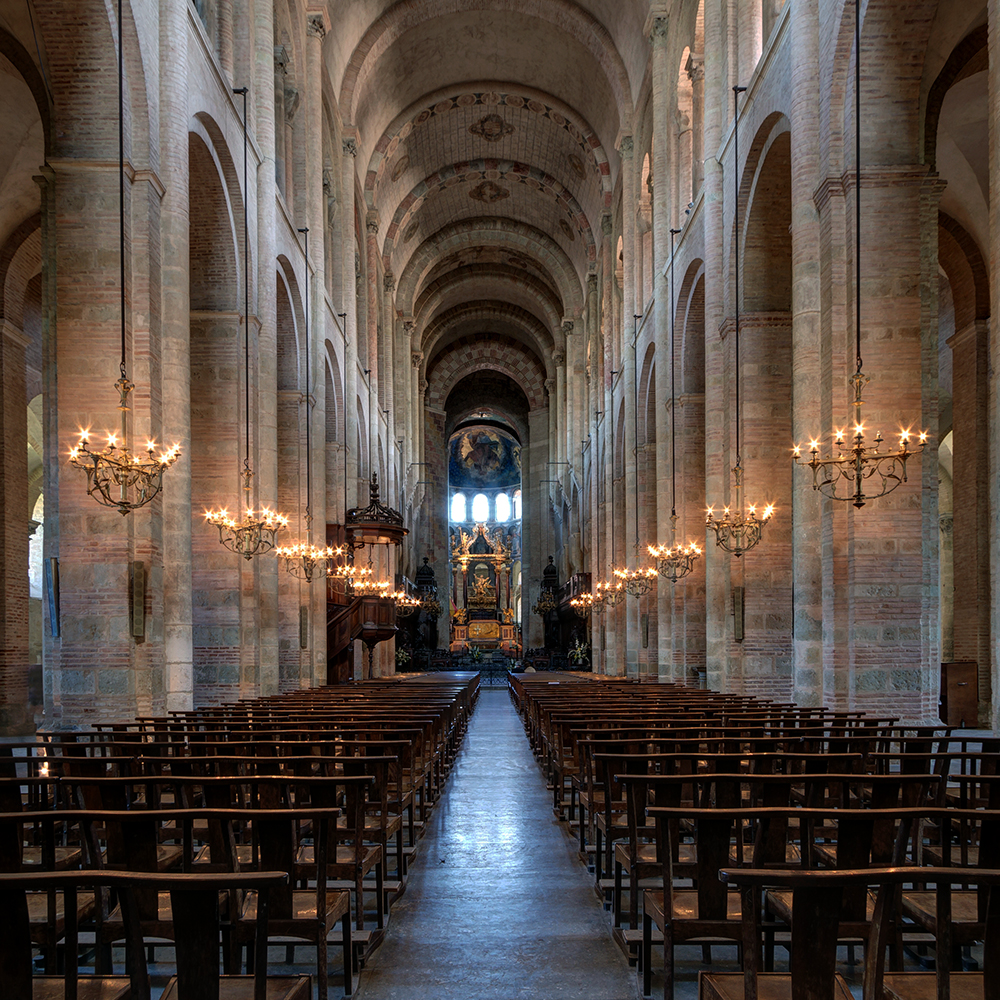
Chapels, sculptures, and the tomb of a saint
The plan of the interior of the church reinforces this function. The large barrel-vaulted central nave is flanked on each side by double side aisles. When standing in the nave the faithful look towards the same high altar that Pope Urban II consecrated on 24 May 1096.

The nave is 69 feet in height and is twelve bays in length from the entrance (the narthex) to the crossing. Each bay is twice as wide as it is long. Harmoniously, these same proportions are mirrored by each of the double side aisles that flank the nave, thus creating a profound architectural unity. This unity is likewise reflected by the arches that separate the nave from the innermost side aisle and the arches in the triforium that allow light to flood into the nave.
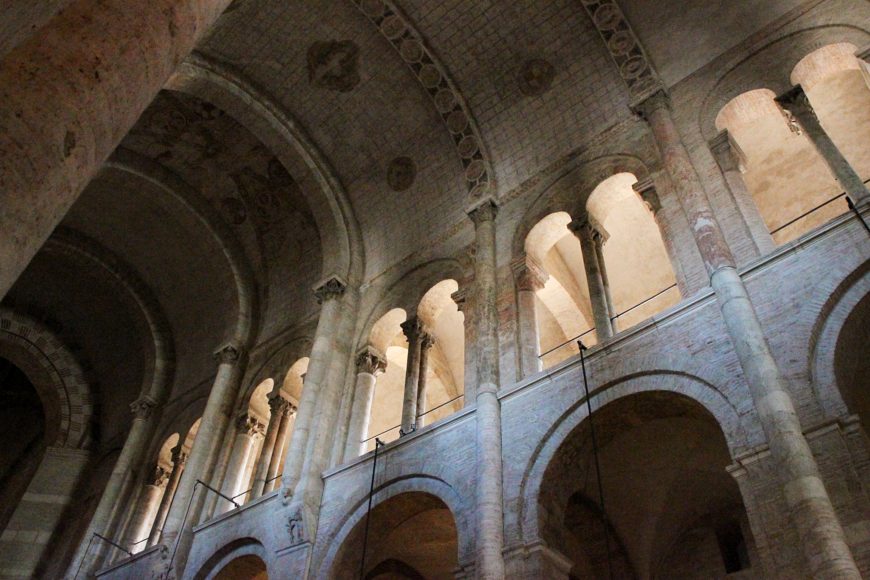
If the primary function of the nave was for the celebration of the Catholic mass, then the double side aisles allowed the throngs of pilgrims who arrived daily to visit the nine radiating chapels without interrupting any religious service in process. A pilgrim might enter the church, turn to their left, and then proceed down a side aisle and move along the transept. From there, they could worship and venerate at any of the nine radiating chapels and see the works of art located in the ambulatory. Of particular note is a large-scale relief of Christ in Majesty that dates from c. 1096. Jesus sits in a shallow mandorla; he raises his right hand in a gesture of blessing while his left hand holds a gospel with the words Pax Vobis — “Peace to You” in Latin — inscribed on the pages. Symbols of the four gospel writers look towards Jesus from the four corners.

The main attraction of the basilica, however, is the tomb of Saint Saturnin that is located on the inner part of the ambulatory. To reach this space, a pilgrim would enter through a doorway where the lintel was carved with the head of Christ flanked by two scallop shells, visual symbols for the pilgrimage trail to Santiago de Compostela. Immediately underneath this lintel — on the iron gate that serves as a barrier — are the words Non Est in Toto Sanctior Orbe Locus; “There is no holier place on earth.”
Saint-Sernin also featured upper and lower crypts that could be visited while in the ambulatory, which contained various shrines and reliquaries. Concluding their visit, the traveling pilgrims would then walk along the side aisle opposite the one they had previously used and then exit the church.
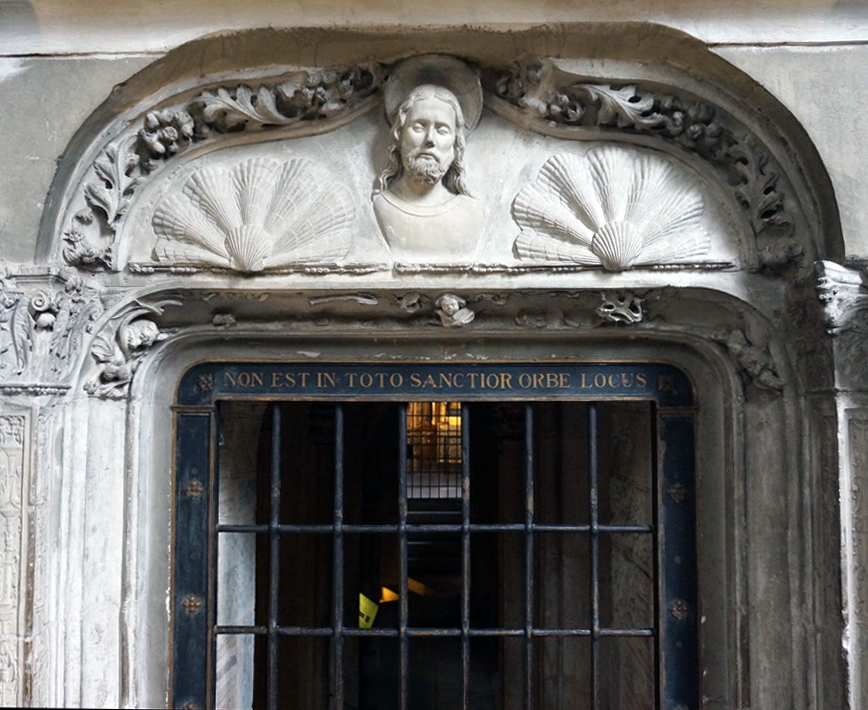
Looking to St. James
While the Basilica of Saint-Sernin may have served as a kind of stopping point for pilgrims on the Way of St. James, it became a kind of pilgrimage destination in its own right in the decades after its construction. Indeed, it is a near contemporary with the Cathedral of Santiago de Compostela (c. 1078), and there is some disagreement about which church is older, as some architectural historians date the groundbreaking for Saint-Sernin to 1077. Regardless of which is older, there is one important note that is generally well accepted: there is clear relationship between the two buildings. Both are Latin cross in plan, and both feature nine radiating chapels on the eastern side of the church. In arriving in Santiago de Compostela, those pilgrims who had traveled together along the southern path of the Way of St. James and had previously visited Saint-Sernin would have encountered a church that familiarly whispered to them.
Fontenay Abbey

The rules
The Romanesque abbey of Fontenay (Abbaye de Fontenay) is located in Burgundy, France and stands today as a prime architectural example of the Cistercian order. Who are the Cistercians, you ask? The Cistercian were (and still are) monks that broke away from the mainstream Benedictines (specifically the Cluniacs), at the end of the 11th century. They are sometimes referred to as the white monks, a reference to their clothing (habit)—a deviation from the Benedictine’s black robes—or as Bernardines, after Cistercian superstar Saint Bernard of Clairvaux.

Essentially, the Cistercians felt the Benedictine monks had become too worldly and were no longer staying true to the Rules of Saint Benedict of Nursia. The Cistercians thought that the amount of time being devoted to manual labor was lacking. The goal of the Cistercians was to adhere strictly to the 6th century Rule of Saint Benedict. This Rule pronounced that a monk should divide his day equally between prayer, study and manual labor, as well as live a life of poverty, chastity and obedience. Most Cistercian abbeys were built to reflect this dedication to the Rule of Saint Benedict, with manual labor being an integral component. Fontenay, a fairly early addition to the order, and built directly under Bernard of Clairvaux, is no exception. Fontenay was the second “daughter house” of Clairvaux, and one of the four founding houses of the order. Saint Bernard held strong beliefs as to how abbeys should be built and, as Fontenay was built under his auspices, it conforms to Saint Bernard’s dictates to a nicety.

Self-sufficiency
Cistercians chose to locate their abbeys in remote areas, far from any sort of hubbub that might interrupt their spiritual meditations. In Fontenay’s case, it was originally founded on the site of an old hermitage. However, due to issues with that site, the abbey was forced to relocate in 1130 to its present location further along the marshy valley. Often Cistercian would take an inhospitable topography and make it livable, such as the marshy site of Fontenay. The Cistercian abbeys focused on complete self-sufficiency, and were akin to mini-towns, rendering the outside world obsolete. Ironically, given the success of the abbeys, they often became the economic hub of the area.

Cistercian abbeys were similar to those of the Benedictines, possessing a dormitory for sleep, a cloister for strolling, a chapterhouse for the monks’ morning meeting, and a caldarium, or warming room where the monks could read and transcribe (also sometimes referred to as a scriptorium). However, an additional feature found at Cistercian abbeys was a wing for lay brothers. Unique to the order, and one of the reasons for its popularity, was the fact they would allow lay men to join. These men were required to adhere to most of the rules of the order but their lives were slightly less strict, and lay brothers could never be ordained or hold office. Fontenay today is remarkably well preserved, though the refectory (cafeteria) was destroyed and the gatehouse restored the 17th century; repairs have also been made to the roof. The abbey still possesses its medieval forge, with its tremendous hydraulic hammer. The forge was an important producer of iron tools and building components in its day.

Harmony and proportion
The Cistercians were known to take an austere tone when it came to ornament. Bernard of Clairvaux felt decoration, whether in the church or in the cloister, would detract from the monks from their heavenly ruminations. With this in mind, Bernard also nixed the crossing tower, which was a common feature in other Romanesque churches, but something Saint Bernard found ostentatious and excessive. A small bell can be found on the roof, as it was a necessity for calling the monks to mass. The Cistercians did, however, lavish acute attention on the construction materials, the stones of the church themselves, generally only using the finest of ashlar masonry.

One enters the church through a singular portal almost completely devoid of ornament aside from the beautiful pink and brown coloring of the stones. The church is in the form of a Latin cross. The east end consists of a flattened apse flanked by two matching square chapels—a deviation from the more common semi-circular apse. Fontenay was dedicated in 1147, making it one of the oldest Cistercian churches in France.
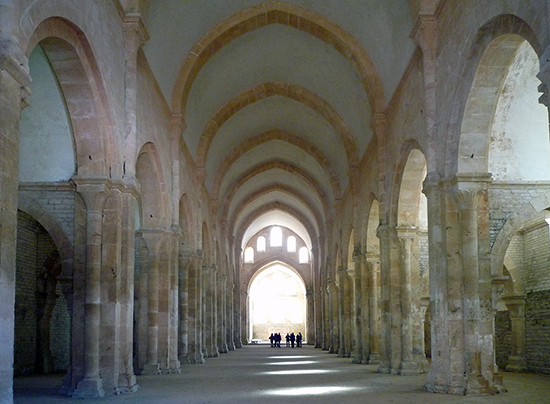
When a visitor enters the church, they are confronted with the symmetrical beauty that is quintessential to the Cistercian abbey. The harmony of proportions might almost make one think of a Classical Greek temple, or the work of later Renaissance architects such as Alberti. Cistercian architecture did inspire Le Corbusier, pioneer of modern architecture. The eight bay nave is flanked by aisles on either side. There is no clerestory. Light only enters from the side aisles on the right, the windows at the east and west ends, as well as windows that pierce the East wall of the crossing transept. The nave is a rounded barrel vault, ever so slightly pointed and the side aisles are likewise supported by barrel vaults which are perpendicular to the nave. Engaged columns coursed into the nave wall connect to the transverse arches above to produce a quiet visual rhythm. As is the case with a number of Cistercian abbeys, the church at Fontenay anticipates the Gothic aesthetic in the way that the barrel vaults are gently pointed.

Into private hands
Like so many abbeys, Fontenay was seized during the French revolution, at which point it ceased to function as a religious center. The property was auctioned off and it became a paper mill in 1791. Later it was be adapted for other industrial purposes until purchased by Edouard Anyard, who restored its structures to their original purity. It remains in the Anyard family to this day, and is open to the public for all to see. It stands as a sober, yet stunning, reminder of the reductive beauty of Cistercian architecture.
Additional resources
Photos of Fontenay from Smarthistory for teaching and learning (CC BY-NC-SA 2.0)
Fontenay Abbey
Smarthistory images for teaching and learning:
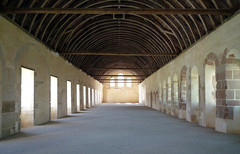
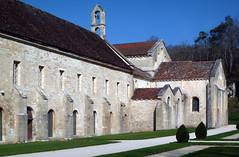
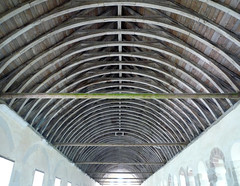
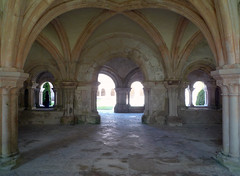
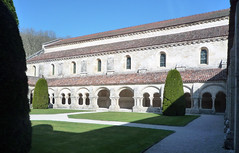
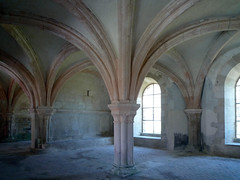
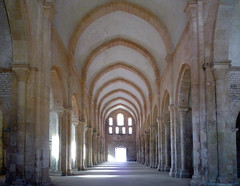

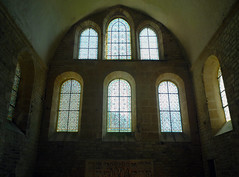
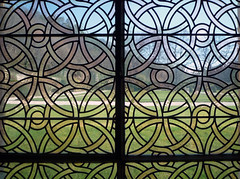
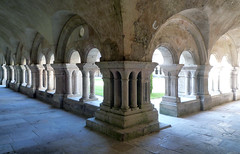

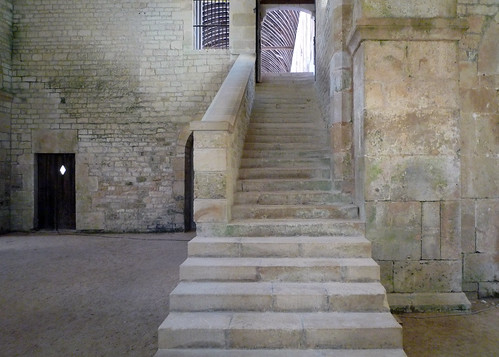
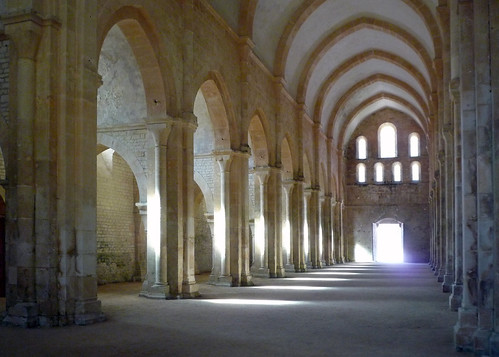
Saint Trophime, Arles
The Provençal city of Arles in the south of France, is home to the medieval church, Saint Trophime.

First impressions
When I first saw the church, somewhat inconspicuously wedged between two more recent structures, it struck me as rather non-descript. However, that impression only lasted a moment.

As I drew nearer, the magnificence of the portal, embellished with an elaborate sculptural program, came into view. Hapless souls, chained and bound, shuffle along to their ultimate doom while Christ in Majesty, surrounded by symbols of his apostles, looks stoically on (the sculptures on the facade depict, in part, the Last Judgment). This is perhaps the finest example of a Romanesque portal to be found in southern France.

The exterior of Saint Trophime was cleaned in recent years—for better or for worse. While it is a pleasure to see the sculpture without a thick black film of pollution, some think these sorts of restorations do more harm than good. The entrance to the cathedral consists of a single arched opening reminiscent of ancient triumphal arches. There are a number of triumphal arches that still stand not far from Arles, in nearby Saint Remy and Orange.
The entirety of the main portal projects outward and it is on this portion of the exterior that the bulk of the church’s sculpture can be found.

Known as the church of Saint Stephen in early Christian times, the church was renamed Saint Trophime when the relics of Saint Trophimus (the first bishop of Arles), in this case a variety of bones, were dug up and reinterred at the church site in 972. Typical for medieval churches, Saint Trophime was constructed over a long period of time and built in a series of campaigns. The structure that is seen today was started in the eleventh century and completed in the twelfth, with a few bits from earlier and later periods thrown in.
A pilgrimage church
The church of Saint Trophime was the first stop on the Via Tolosa, one of the main pilgrimage routes through France leading to Santiago de Compostela in Spain. The church was also the episcopal seat, or home to the bishop’s chair, from the early fifth century until the early nineteenth century, giving this structure cathedral status.
Saint Trophime is Romanesque in style, as opposed to Gothic, and one way this can be seen is in the tell tale rounded arch of the front portal. Gothic structures tended to favor a tall pointed arch. Likewise, a heavy barrel vault covers the nave, as opposed to a pointed rib vault (which became a hallmark of Gothic architecture). It should be noted that the barrel vault at Saint Trophime is slightly pointed, perhaps hinting at the Gothic age to come.
Inside the church
The interior, though not as decorative as the facade, is just as impressive. When visitors enter Saint Trophime, they are greeted by a high nave (the long central hall). In fact, standing 20 meters/65 feet high, this is the tallest nave in Provence and is equivalent to a six story building.

The nave is flanked by tall, narrow side aisles, which are covered by half-barrel vaults. Side aisles are fairly unusual in medieval Provençal churches, the tendency being toward single nave buildings. Because Saint Trophime was a cathedral at the time of its construction, it may have warrented a more complex and expansive design (at least in comparison to nearby parish churches).
The nave of Saint Trophime is composed of five bays and communicates with the side aisles via arcades that are slightly pointed like the main barrel vault. The elevation is a straightforward two-story design, consisting of an arcade and a clerestory (the upper portion of the wall pierced by windows).
Despite this, Saint Trophime is still rather dark, perhaps due its large size. The nave and aisles are crossed by a transept, which creates the plan’s cruciform shape. There is a crossing tower above the intersection of the nave and trancept supported on squinches (support that help transition from the rectangular form of the bay up to the octagonal form of the tower), a common feature of Provençal churches.

This tower reaches a stately height of roughly 42 meters or 137 feet! The east end terminates in three semi-circular apses. The central apse and ambulatory was rebuilt in the fifteenth century, and therefore reflects a Gothic sensibility in its use of pointed arches and rib vaults. The remainder of the church is a true Romanesque gem.
A regional style
Provence, along with many other regions, developed its own unique Romanesque style. Saint Trophime is a wonderful representation of some of the facets of this Provençal regional style. For example, it is built of finely dressed ashlar masonry, meaning it uses precisely cut stones and little or no mortar. Given the number of stones needed to create this building, this was no small feat! There would have been no speedy stone saws, only a mason’s trusty chisel and mallet. Despite the time and labor involved, this was a common building practice in the area.
Many of these stones are emblazoned with prominent markings, often resembling letters of the alphabet. These are called mason’s marks and were also common to local masonic practice. Mason’s marks were used for a variety of purposes, including payment and placement of the stones.
The sculpture within
The interior of Saint Trophime is much more austere than the portal or cloister, another attribute typical to the Provençal Romanesque style. However, the interior of Saint Trophime is not without ornament.

Of special note are the classically inspired Corinthian columns (fluted columns surmounted by a scroll and acanthus leaf capital) that can be found just below the springing of the main nave vault. There is also a stringcourse molding running the length of the nave just above the clerestory carved in an acanthus leaf pattern. Both the Corinthian column and the acanthus leaf molding were favorites of the ancient Romans.Arles abounds with Roman ruins, including an arena, a theater and the remains of a bath complex. It is easy to see how local medieval builders may have been inspired by the Roman remains they would have seen daily.
The Last Judgment portal
The portal tympanum (illustrated above) displays Christ in Majesty surrounded by the four apostles represented in symbolic form: John (eagle), Matthew (angel), Luke (ox), and Mark (lion). This is also known as the tetramorph. Those chosen for heaven, including bishops and priests, sit at Christ’s right. At Christ’s left stands an angel brandishing a sword, effectively blocking the damned from paradise. The condemned souls, with hellfire licking at their legs, seem to be taking their damnation in stride (above). The carving, exquisite though it may be, does not convey the same strong emotions present in some contemporaneous churches such as at Moissac.


The Last Judgment and Second Coming are common subjects for Romanesque portals, particularly for those churches along the pilgrimage routes. The Saint Trophime version is notable in its overall stoicism despite the drama of the subject matter.

The portal is jam-packed with sculpture. There are a number of other biblical scenes included in addition to the Last Judgment, particularly from the early life of Christ. For example, if one looks at the lintel just to the right of the doorway, the Adoration of the Magi can be seen. Below those registers a host of saints, including Peter, John, Paul, Stephen and Trophime himself, glare into the middle distance, giving the viewer the sense that they too have been judged and been found wanting! The grand entranceway’s symmetrical organization into clear registers gives it an orderly and uniform appearance, everlasting hellfire not withstanding.
Backstory
Saint Trophime was designated as a UNESCO World Heritage site in 1981 because of its status as a prime example of Romanesque architecture in France, and its importance as the starting point of one of the millennium-old pilgrimage routes to Santiago de Compostela in Spain. The World Monuments Fund (WMF) has been a key supporter of ongoing efforts to preserve and restore the building.
After sponsoring the restoration of the building’s facade in the 1990s, the WMF began the project of documenting and restoring the cloister in 2009. Their efforts involved the application of new technologies—in particular, 3-D laser scanning and high-definition photography by the non-profit organization CyArk and the engineering firm Christofori and Partners. The resulting documentation of the building was used to consult with many international experts who contributed valuable knowledge to the restoration, and it also preserved the building in digital form, making the information available for users around the globe. The WMF then oversaw the cleaning and restoration of the interior stone work, sculptures, terracing, and columns, including a type of laser-cleaning that carefully removes layers of accumulated soiling on the delicate marble.
This project demonstrates not only the importance of continued maintenance for important monuments, but the benefits of digital documentation for both expert planning and research as well as for the wider public. The open accessibility of the 3-D models and photographs online through CyArk is a cutting-edge example of how cultural heritage, and its continued importance for everyone, can be emphasized and shared around the world.
Backstory by Dr. Naraelle Hohensee
Virgin and Child in Majesty
by THE METROPOLITAN MUSEUM OF ART
Video \(\PageIndex{4}\): Virgin and Child in Majesty, c. 1175-1200, made in Auvergne, France, walnut with paint, tin relief on a lead white ground, and linen,
31 5/16 x 12 1/2 x 11 1/2 inches / 79.5 x 31.7 x 29.2 cm (The Metropolitan Museum of Art). Video from The Metropolitan Museum of Art. View this work in the online collection.
Italy
The Basilica of San Clemente, Rome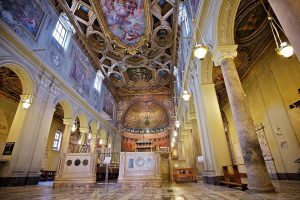
A shrunken Rome
By the twelfth century, the city of Rome was a shadow of its former, imperial Roman self. Pilgrims still flowed into the city from all over Europe in recognition of Rome’s status as the home of the pope and the burial place of apostles and the Early Christian martyrs, but the city itself had shrunk dramatically inside the old Roman walls. Rome was regularly sacked by invaders, including the Holy Roman Emperor, a northern noble supposedly appointed to protect Europe’s Christians. It was also damaged by battles between the city’s most powerful families. For parts of the twelfth century, two popes, each chosen by a rival faction, concurrently claimed to lead the Western Church. Nonetheless, the city was gripped by a spirit of religious renewal that led patrons to rebuild several of its important churches. Romans were so proud of their city’s Christian past and current status as the capital of Western Christianity that these new buildings often closely copied the early churches they replaced.
Building on Roman foundations
The Basilica of San Clemente, located in the heart of medieval Rome, is an example of this faithful copying. It was rebuilt in the early twelfth century on the site of an Early Christian house church, using the existing basilica church already on the site as its foundations. The builders mimicked the earlier church in almost every way, copying its nave, aisles, arcades (arches) with columns made from Roman spolia, clerestory windows, a simple apse, and an open wooden roof (now hidden by an ornately decorated ceiling). They departed from the earlier model only by making the new structure slightly narrower and inserting piers halfway down the nave. To a medieval viewer, the ancient Roman heritage of the building would have been obvious, though today it has mostly been obscured by an exuberant eighteenth-century renovation.
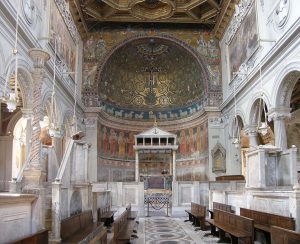
An old fashioned schola cantorum—the choir enclosure where the men or boys who sang the words of the services would sit—is located in the middle of the church. At one time every Roman church would also have had a similar set of raised ambos (lecterns), a towering pedestal for the paschal candle, and rows of seats facing each other so that the choir could sing in alternation between each prayer and reading.
Blending Christian and classical
The decoration of the church also looked back to earlier precedents. The artists of the apse mosaic adapted the pagan and Christian motifs found in Late Antique and Early Christian mosaics and sculptures still visible in Rome. On a field of gold, a luxuriant, leafy, flowering scroll springs from a base of acanthus leaves. Naked, winged cherubs ride dolphins or play instruments among the branches, baskets of fruit spring from their ends, and shepherds herd sheep and milk goats in the landscape below. Below the cherubs Early Christian church fathers teach and serve.
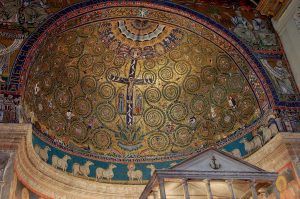
Grafted onto this bucolic scene are explicitly Christian themes. Between the shepherds, peacocks, geese, ducks and deer lap up the healing waters from the four rivers of Paradise. At the center, Jesus hangs on a cross studded with twelve doves, symbolizing the apostles. At the base, twelve sheep walk from miniature depictions of the walled cities of Jerusalem and Bethlehem towards an apocalyptic lamb with a crossed nimbus (below). An inscription at the bottom explains, “We liken the Church of Christ to this vine that the law causes to wither and the Cross causes to bloom.”
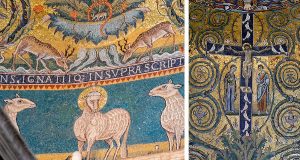
On the spandrels of the arch, the prophets Saint Clement and Saint Lawrence and the apostles associated with Rome, Peter and Paul, wear the anachronistic uniform found in medieval depictions of holy figures: the chiton, himation and sandals worn by ancient aristocrats.
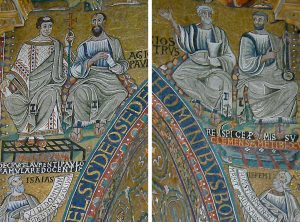
With the flanking figures, the mosaic argues that the Western Christian church, based in Rome, is more powerful than the secular forces that had recently sought to control it. And like the church of San Clemente itself, it demonstrates that, despite the precarious political situation in Rome during this time, its inhabitants looked to publicly display the city’s status as the center of Western Christianity.
Additional resources:
Basilica of San Clemente on Google Arts and Culture
Richard Krautheimer, Rome: Profile of a City, 312-1308 (Princeton: Princeton University Press, 1980).
Michael G. Sundell, Mosaics in the Eternal City (Tempe: Arizona Center for Medieval and Renaissance Studies, 2007).
The Romanesque churches of Tuscany: San Miniato in Florence and Pisa Cathedral
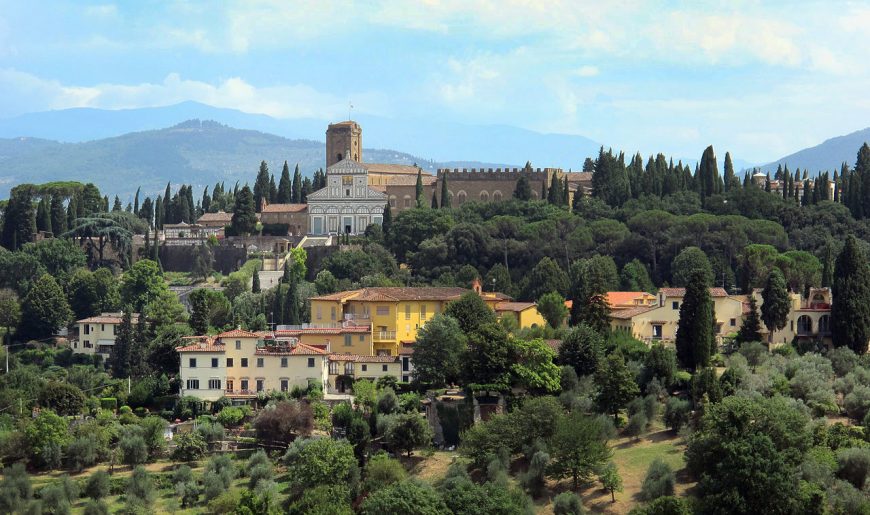
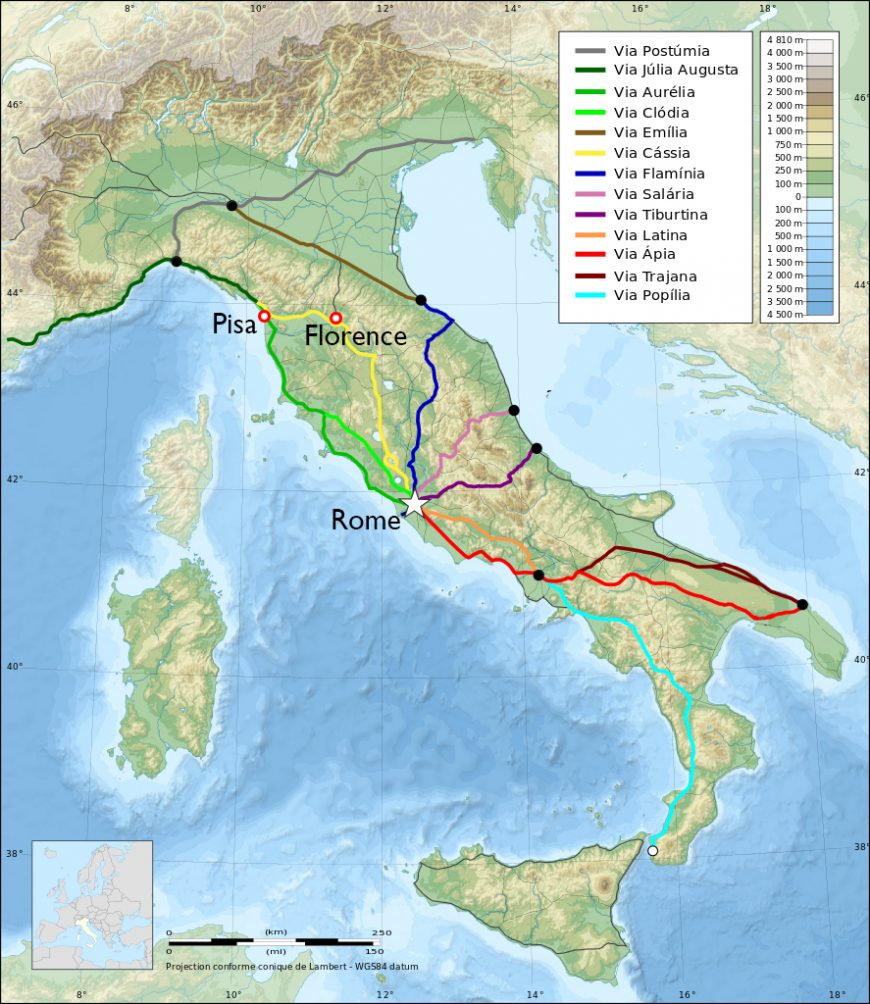
Before the Italian peninsula was unified into a single nation in the nineteenth century, it was divided into numerous separate countries, papal-controlled territories, and city states with constantly shifting boundaries. Unlike regions north of the Alps, in Italy the durable old Roman roads that snaked down the length of the peninsula were preserved by mild weather and continuous use. The former Roman cities along these roads became hubs of trade. These included Florence on the Via Cassia between Rome and the old central Italian heartland, and Pisa, on the Via Aurelia between Rome and what was known as “Roman Gaul” (today France and Belgium).
Roman walls, aqueducts, monuments, and buildings dotted the landscape, and this Roman heritage profoundly impacted the appearance of the region’s churches. During the middle ages, residents of the cities of Tuscany valued their Roman past, particularly as it was associated with the origins of institutional Christianity. Although Tuscany was a duchy and controlled by the Canossa family, in reality the cities of Tuscany soon established their own governments and civic identities.
Florence and Pisa are wonderful examples of this. During the eleventh century, each city’s Roman heritage was still visible in the form of roads and bridges, walls and cemeteries, but each city also took on its own character based on the preferences of its inhabitants and the sources of their economic strength. The architecture of San Miniato in Florence and the Cathedral of Pisa visibly express both their unique regional and civic qualities, as well as links to the Roman past.
A monastery on a hill
The church of the Benedictine monastery of San Miniato al Monte (above) lies outside the early medieval walls and across the Arno from Florence. It hovers over the city on the crest of a hill, or “monte,” where Florentines believed the cell of Saint Minias, an Armenian Christian hermit who was allegedly martyred by the Roman Emperor Decius in the third century, once stood. By 1018, the bishop of Florence had ordered the construction of a church and installed a community of Benedictine monks there, following a familiar medieval pattern of locating monasteries outside, but within a short distance of, a city so that the monks could minister to the spiritual needs of the city’s inhabitants.
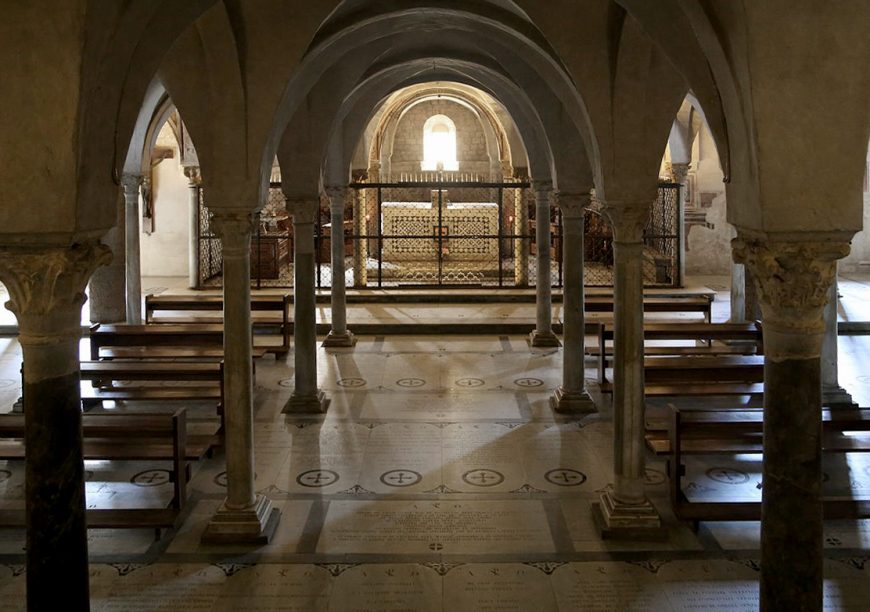
A synthesis of forms
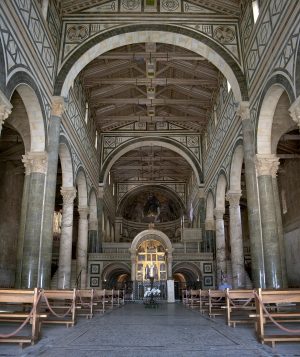
The builders cleverly designed the church so that it could accommodate visitors to the tomb of Minias. Adapting a basilica-style structure with its single apse and a trussed timber roof, the builders incorporated an innovative raised chancel. Central stairways allow visitors to see and visit the crypt housing Minias’s relics, while flanking stairways lead to an elevated platform holding the altar and choir used by the monks.

A similar synthesis of ancient, Early Christian, and medieval forms is visible in the church’s walls. An arcade of polished stone columns supporting Corinthian capitals march down the nave, above which colorful stone inlay brightens the surface—all reminiscent of Early Christian basilicas like Santa Sabina in Rome. Many of the capitals are Roman spolia, noticeable because they are much narrower than the columns they crown.
The roots of Florentine style
Yet onto this traditional framework the builders grafted imposing diaphragm arches that divide the nave into three massive bays, marked on the walls with attached columns and compound piers. The green and white stone inlay familiar from some Early Christian interiors clads the surfaces of the façade and the interior (though in some places, after money ran out, artists imitated the decorative stone in paint). This style of construction, joining modified basilican architecture with colorful, two-dimensional stone inlay, would become typical of the Florentine region.
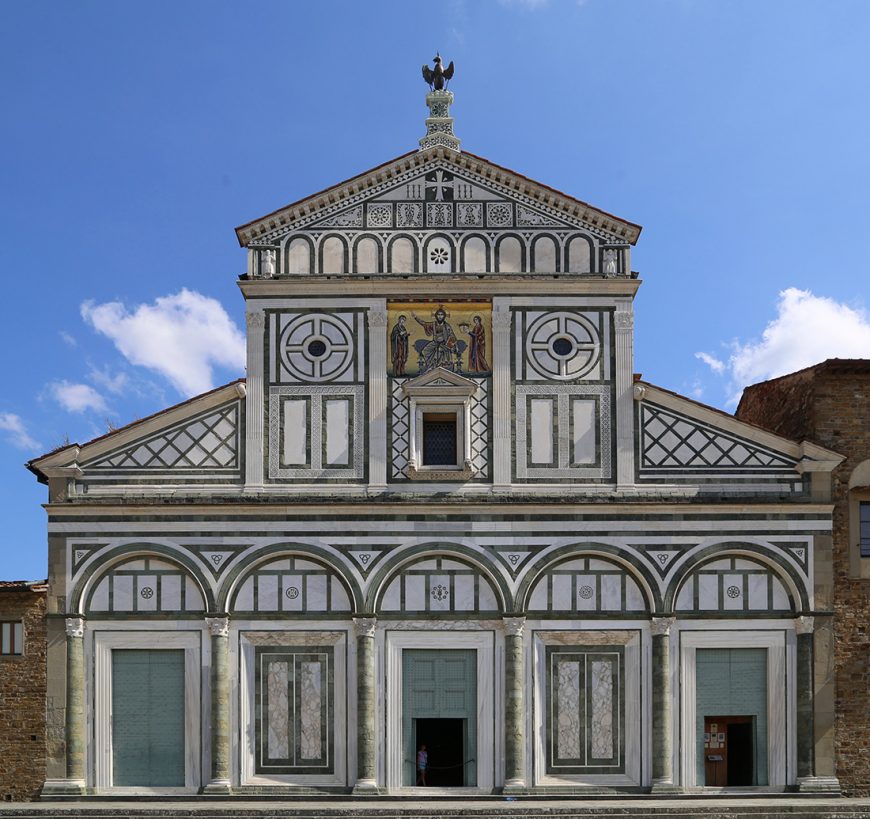
The façade also references the Roman past. Although the component parts are flattened and rendered in pink, green and white stone, we can still identify an orderly row of columns topped by Corinthian capitals, crowned by a set of four Corinthian pilasters holding a triangular pediment that recalls a Roman temple front. In the fifteenth century, the Renaissance architect Leon Battista Alberti, would use many of the same elements in crafting the typically Tuscan façade of Santa Maria Novella, across town.
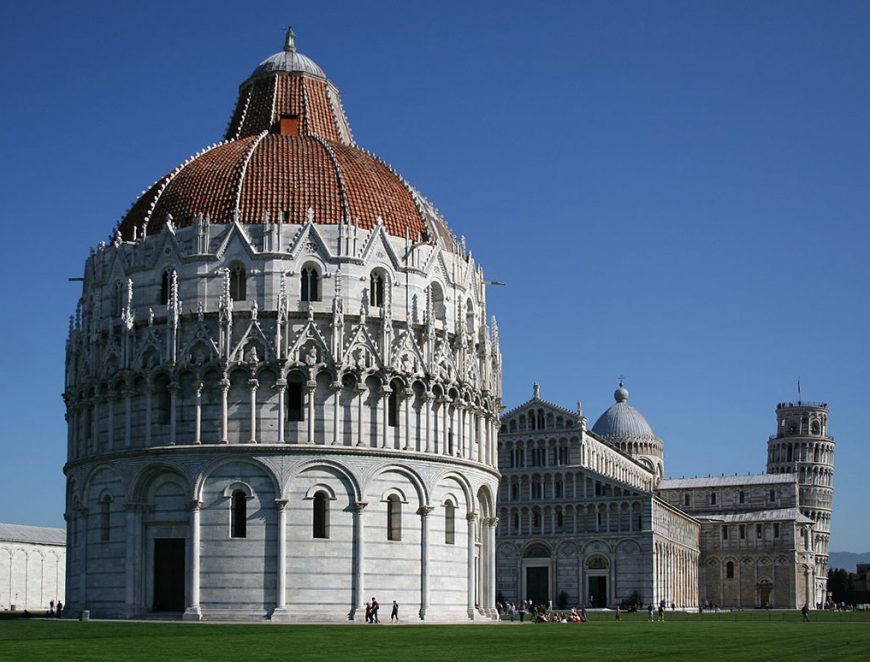
Pisa and its “Leaning Tower”
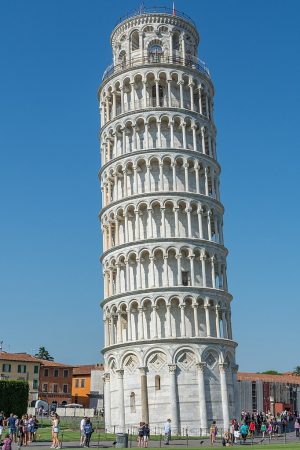
The Arno, the river that flows through Florence, eventually reaches the city of Pisa on its way to the Mediterranean Sea. In the Middle Ages, before the river’s silt deposits pushed the sea away, Pisa was located very near the coast. It was an important port city from Roman times onwards, and by the eleventh century it became a maritime republic (a city-state whose economic base was maritime trade), competing with the other Italian naval powerhouses like Genoa, Venice, and Amalfi to dominate Mediterranean trade. Pisa warred constantly with rival maritime powers in Corsica, Sicily, North Africa and on the Italian mainland. The cathedral for which it is now famous was built starting in 1063, in the wake of, and using booty from, Pisa’s naval victory over Palermo.
Like most cathedrals on the Italian peninsula, Pisa’s was built as an assemblage of freestanding buildings, including a baptistery and bell tower (campanile) in addition to the church. The Pisa cathedral complex was unusual, however, in that it was situated well outside the city walls in a grassy precinct that incorporated an ancient cemetery. Surrounded by the marshes of the Arno, the precinct’s damp soil contributed to unstable ground under the complex’s key structures, most noticeable in the campanile, which began to lean even while it was still being built in the twelfth century.
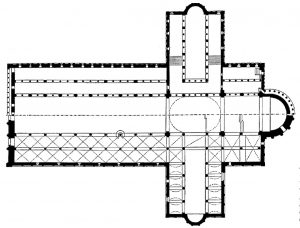
Old meets new
Pisa Cathedral, like San Miniato, borrows heavily from the architectural past. It has a basilica footprint with double aisles separated from the nave by colossal Corinthian columns, a trussed timber roof, and a single semicircular apse, all perhaps intended to recall Old St. Peter’s in Rome. Each of the arms of the transept repeats this basic formula on a smaller scale, with single aisles flanking a central space that leads to a smaller apse, creating a four-armed groundplan. This and the substantial galleries below clerestory windows recall the basilicas of the early Byzantine east.
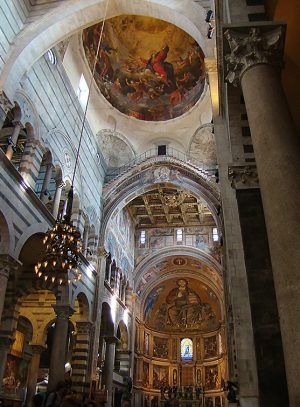
The builders also added new features. Above the arcade and galleries and between the clerestory windows one finds expanses of cream and green striped wall. Although the pattern here is different from that found on the walls of San Miniato in Florence, both share the same complexity and conspicuous display of expensive materials.
An unusual dome
Although they probably originally planned a simpler wooden covering for the crossing, by the end of the eleventh century the builders had begun to construct a dome, perhaps to keep pace with contemporary domes built north of Tuscany in Lombardy, or even by Pisa’s economic rival, Venice. The unusual and complicated elliptical shape was dictated by the rectangular outline of the crossing created by the meeting of the nave, choir and transepts. The builders bridged the corners of this opening under the dome’s base with Byzantine-inspired squinches that resemble those built at Hosios Loukas in Greece just a few years before. Above the squinches, subtlely incised blind arcades can be seen. The colorful fresco depicting the Assumption of the Virgin was added in the 17th century.
A virtual Holy Land
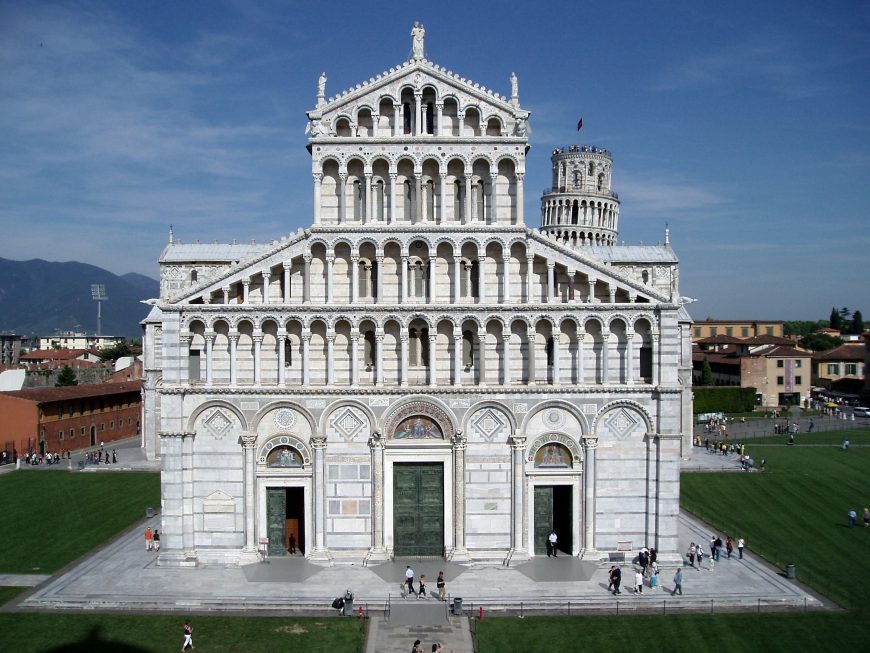
Most impressive to medieval visitors would have been the exterior. The simple geometry of the façade immediately recalls San Miniato’s stack of rectangles and triangles, all resting on a shallow arcade with Corinthian capitals that frame three doors. At Pisa, though, above the ground floor, the façade becomes dramatically three-dimensional, with open arcades that screen a wall decorated with grey and white stripes.
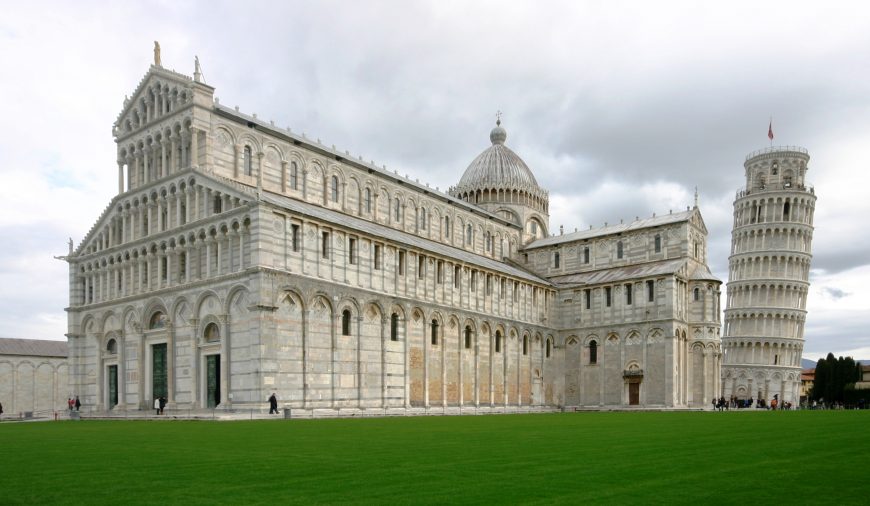
On the church’s sides, transept, and apse, the grey and white stone has been embellished with blind arcades and colonnades (rows of columns). Lozenges, roundels, and rectangles of multicolored stone inlay dot the exterior.
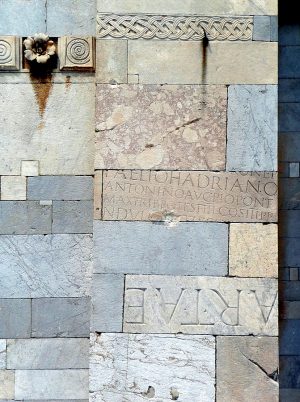
Reused stones covered with inscriptions and sarcophagi imported from Rome are inserted seemingly at random: a testimony to the builders’ desire to invent an ancient heritage for the building and demonstrate the wealth and power of Pisa.
The other buildings in the complex, built starting in the twelfth century after the Pisan navy participated in the First Crusade, complete this sumptuous display. The centrally-planned, domed baptistery may have been intended to imitate the church of the Holy Sepulchre in Jerusalem. It and the leaning campanile are completely encased in stacked arcades, mirroring those on the cathedral. The “Camposanto,” an enclosed cemetery, was filled with earth imported from the Holy Land in the holds of Pisan ships. Pisans may have imagined this collection of buildings, with its many references to ancient Christian sites, as a virtual Holy Land, a site they were then trying to reconquer.
Each a product of its particular region, San Miniato and Pisa Cathedral speak to the ways that medieval builders sought to express their cities’ unique identities through both ancient allusions and innovative forms.
Additional resources:
San Miniato al Monte on Google Arts and Culture
Plan and elevation of San Miniato al Monte at the Courtauld Institute
Piazza del Duomo, Pisa on the UNESCO World Heritage website
Photos and 3-D models of Piazza del Duomo from CyArk
Diane Cole Ahl, “Camposanto, Terra santa: Picturing the Holy Land in Pisa,” Artibus et Historiae 24 (2003), pp. 95-122.
Kenneth John Conant, Carolingian and Renaissance Architecture 800-1200 (New York: Penguin, 1978), pp. 372-382.
Romanesque art in England
The Normans crossed the channel and invaded England in 1066. The works that followed testify to the power of art and architecture as a tool for colonization.
The Art of Conquest in England and Normandy
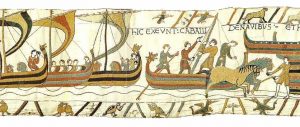
The invasion
On September 28, 1066, the tiny community of Pevensey (on the south-east coast of England), huddled inside the ruins of a late Roman fortification. They would soon be overwhelmed with the arrival of William, Duke of Normandy, and an army intent on invasion. Thousands of invaders had crossed the English Channel from Normandy on hundreds of open longships that were big enough to carry cavalry horses and the supplies needed to lay siege to the coastal cities guarding England.

William had been preparing for the invasion since the last Anglo-Saxon king of England, Edward the Confessor, had died without a direct heir months earlier.
Edward had been succeeded by a newly appointed ruler, Harold Godwinson, but both William and the King of Norway, Harold Hardrada, also laid claim to the throne. Harold Hardrada had crossed the North Sea to invade near present-day Newcastle in the north of England, arriving at almost exactly the same time as William’s army made land further south. Forced to defend two coasts almost three hundred miles apart in quick succession, Harold Godwinson succeeded in defeating the king of Norway, but fell on the field at the Battle of Hastings, just up the coast from Pevensey, shot through the eye with an arrow. Harold’s sizeable army was no match for the mounted warriors William had brought from Normandy. His forces quickly marched west, to Dover and Canterbury, then east, leaving devastation in their wake. By Christmas, 1066, William the Conqueror had been crowned king of England, but facing a rebellion, he continued to lay waste to a huge swath of the country before he had all of England firmly within his grasp.

Weaving a Norman tale
The works of art and architecture made in the wake of this invasion testify to the power of art as a tool for colonization. Perhaps the most famous of these is the Bayeux Tapestry. Within twenty years of the Norman Conquest of England, needle-workers embroidered dozens of scenes describing the invasion onto this 230-foot-long linen strip using wool and linen yarn. Between narrow upper and lower borders populated by animals, people and objects that act as a subtle commentary on the central narrative, a history of the Norman Conquest unscrolls from left to right, ending abruptly with a tattered, incomplete scene of mace-wielding Anglo-Saxon foot soldiers fleeing the victorious Normans. Embroidered Latin titles help to identify people, places and events.

Scholars have never pinned down where or by whom the embroidery was carried out, or where it was meant to be displayed—a mystery compounded by the fact that this is the only storytelling textile strip of this sort preserved from the Middle Ages. In it, William is portrayed ordering his men to build a fleet of longships, stock them with arms and armor, food, wine, and horses, and set sail for England, where they feast, plan, and finally attack. The ensuing slaughter is unflinchingly rendered: in the lower border, dismembered bodies are stripped by battlefield looters. The style of the tapestry, with its gangly-limbed, beaky-nosed figures, agitated gestures, stolid drapery folds, abrupt changes in scale, and multicolored trees made of rubbery, interlaced fronds, has similarities to other works found on both sides of the Channel. Anglo-Saxon England and the Duchy of Normandy had been exchanging artwork, artists, clergy, and nobles well before the Conquest (their rulers were closely related—King Edward the Confessor’s mother, Emma of Normandy, was William the Conqueror’s great aunt).

If we can’t use style to judge where the tapestry was made, we can instead turn to the story, which displays an indisputably Norman bias, to identify its intended audience. Many medieval texts retold the events of the invasion from both the Anglo-Saxon and Norman perspectives, but Bishop Odo of Bayeux, William’s half brother, figures prominently in the Bayeux tapestry, where he is shown blessing a feast on the eve of battle, advising William, and rallying the troops. It is likely, then, that Odo commissioned the tapestry to celebrate his brother’s victory, and the tale that unfolds along its length highlights William’s (and Odo’s) valor and the supposed wrongdoings of Harold Godwinson, who is depicted swearing an oath to be William’s vassal, but then allowing himself to be crowned King of England. The tapestry completely ignores Harold’s victory over the Norwegian king, instead focusing on events of interest to Normans.

Motte-and-bailey castles
While the tapestry’s renditions of ships, weapons, horses, feasts and buildings have been mined by historians for information about daily life and military campaigns, many details are doubtless the result of artistic license. Still, the tapestry showcases some important Norman innovations. After the feast presided over by Bishop Odo, the invaders are shown shoveling dirt onto a striped mound crowned by a structure labeled “Hesteng ceastra“ (above). This is the castle of Hastings, one of several such castles (including one at Dover, discussed below, as well as the Tower of London) that William had built during and after his invasion. With these, he imported into England a type of defensive structure that was typical in Normandy and became essential for establishing control over his new English subjects.
The simplest of Norman castles comprised a mound, or motte, of alternating layers of earth and stones, topped with a wooden palisade and an enclosed residence, or keep, and surrounded by a ditch. Either surrounding this or contiguous with it was an open yard, or bailey, ringed with a wooden defensive barrier. Such defenses could be thrown up quickly and made use of existing land features. They provided security for the soldiers, horses, and equipment necessary to subdue the surrounding inhabitants, a vantage point from which to observe potential foes, and a looming presence to intimidate them.
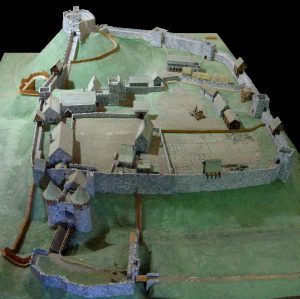
Lacking a standing professional army that could defend the walls of a city, medieval rulers like William appointed nobles to subdue parcels of the countryside in return for land and goods. If a castle’s location proved to be advantageous in the long term, the wooden structure on top was replaced with a masonry keep that provided permanent and more comfortable housing for the governing lord and his family. Round, rectangular, or faceted, these could be hollow shell keeps with buildings clustered against an exterior wall, or solid great towers, like the keep at Dover (below).
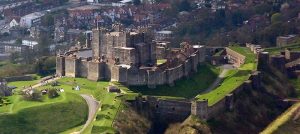
Topping these structures one often sees crenellations, which allowed archers to defend the perimeter while sheltering behind a stone wall. At Dover, as was typical, the wooden palisade surrounding the bailey was over time replaced by multiple concentric stone walls, a moat, and a barbican (an outer fortified gate).
With its towering presence, the motte-and-bailey castle combined the practical functions necessary to govern a rural population or the inhabitants of a conquered city with the symbolism of domination.

A Norman cathedral
William the Conqueror had first visited Durham Cathedral—then an Anglo-Saxon stone church—on its peninsula in a bend of the River Wear (above) on his first northern campaign. Durham Cathedral was an important touchstone of Anglo-Saxon national identity, holding the relics of Cuthbert, their patron saint. Recognizing its strategic importance, William fortified one end of the site with a motte-and-bailey castle, and invited another Norman, William of Saint-Calais (who then became Bishop William), to take over the venerable cathedral and remake it in the image of a Norman church. Bishop William expelled the clergy he found there and replaced them with Benedictine monks. By 1093, he had begun construction on the largest and most technically innovative Norman church of its time.
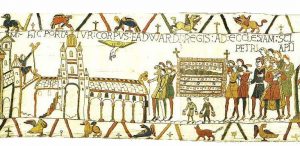
The Anglo-Saxons were already familiar with some Norman building practices and styles. In the Bayeux Tapestry, we see Edward the Confessor’s body carried to Westminster Abbey, which had been dedicated just days before his death. The church is depicted as a substantial structure with arcades (here, rows of columns topped with arches), clerestory windows, a transept and multiple towers. Edward had built it to be his own burial church, and excavations show that it probably resembled a Norman abbey near where Edward had spent much of his youth. At the time, observers described Westminster Abbey’s style as new and unusual. In the wake of the Conquest, however, major English churches were built or rebuilt only in this style rather than in the then prevalent Anglo-Saxon style, marking Norman control of the Church in starkly visual terms.
William the Conqueror and his wife, Matilda, had already commissioned impressive church buildings in their Norman capital city, Caen, that showcased the key characteristics of the Norman style. We can also see these at Durham, begun after William’s death but still part of the legacy of his invasion. A façade with two monumental towers looms over the fortifications and the steep banks of the Wear surrounding Durham’s peninsula. Behind this façade, a broad nave is separated from aisles by massive arches framed with complex decorative stone moldings, sitting on gigantic alternating piers.
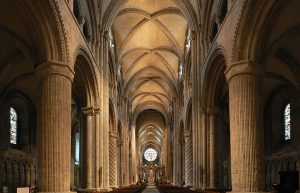
Heavy stone, cleverly disguised
The clerestory windows of the nave and transept sit behind an interior passage and yet another arcade that create the effect of a multi-layered wall. Soaring over this multitude of arches are gargantuan ribbed groin vaults that covered the broad main area of the church, were probably the earliest and certainly the widest in Norman architecture. Their lightness and clever variations in curvature and height attest to the technical prowess of the builders. Stonemasons embellished the arches and piers with intricately carved patterns, and incised the outer wall of the aisle with interwoven arches. With these layers and details, the cathedral’s builders and masons emphasized the colossal weight of stone that supports the vaults, while at the same time diffusing this effect of weightiness using surface ornamentation. Together the technically demanding vaults and the wealth of hand-carved decoration broadcast the power of the cathedral and its bishop, who had the means to command the materials and artisans necessary to build such a monument.
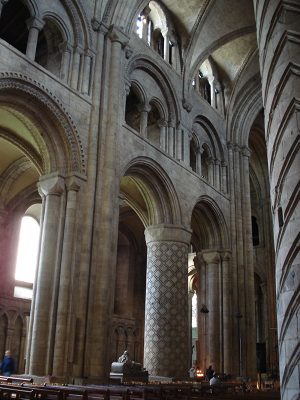
Led by a decisive ruler, the Norman invaders at the beginning of the eleventh century brought with them a rich set of artistic and architectural approaches that helped them display their new power and authority over the Anglo-Saxon population.
The Bayeux Tapestry
The Bayeux Tapestry
by DR. KRISTINE TANTON


Measuring twenty inches high and almost 230 feet in length, the Bayeux Tapestry commemorates a struggle for the throne of England between William, the Duke of Normandy, and Harold, the Earl of Wessex (Normandy is a region in northern France). The year was 1066—William invaded and successfully conquered England, becoming the first Norman King of England (he was also known as William the Conqueror).
The Bayeux Tapestry consists of seventy-five scenes with Latin inscriptions (tituli) depicting the events leading up to the Norman conquest and culminating in the Battle of Hastings in 1066. The textile’s end is now missing, but it most probably showed the coronation of William as King of England.

Although it is called the Bayeux Tapestry, this commemorative work is not a true tapestry as the images are not woven into the cloth; instead, the imagery and inscriptions are embroidered using wool yarn sewed onto linen cloth.
The tapestry is sometimes viewed as a type of chronicle. However, the inclusion of episodes that do not relate to the historic events of the Norman Conquest complicate this categorization. Nevertheless, it presents a rich representation of a particular historic moment as well as providing an important visual source for eleventh-century textiles that have not survived into the twenty-first century.

The Bayeux Tapestry was probably made in Canterbury around 1070. Because the tapestry was made within a generation of the Norman defeat of the Anglo-Saxons, it is considered to be a somewhat accurate representation of events. Based on a few key pieces of evidence, art historians believe the patron was Odo, Bishop of Bayeux. Odo was the half-brother of William, Duke of Normandy. Furthermore, the tapestry favorably depicts the Normans in the events leading up to the battle of Hastings, thus presenting a Norman point of view. Most importantly, Odo appears in several scenes in the tapestry with the inscription ODO EPISCOPUS (abbreviated “EPS” in the image below), although he is only mentioned briefly in textual sources. By the late Middle Ages, the tapestry was displayed at Bayeux Cathedral, which was build by Odo and dedicated in 1077, but its size and secular subject matter suggest that it may have been intended to be a secular hanging, perhaps in Odo’s hall.

We do not know the identity of the artists who produced the tapestry. The high quality of the needlework suggests that Anglo-Saxon embroiderers produced the tapestry. At the time, Anglo-Saxon needlework was prized throughout Europe. This theory is supported by stylistic analysis of the depicted scenes, which draw from Anglo-Saxon drawing techniques. Many of the scenes are believed to have been adapted from images in manuscripts illuminated at Canterbury.

The artists skillfully organized the composition of the tapestry to lead the viewer’s eye from one scene to the next and divided the compositional space into three horizontal zones. The main events of the story are contained within the larger middle zone. The upper and lower zones contain images of animals and people, scenes from Aesop’s Fables, and scenes of husbandry and hunting. At times the images in the borders interact with and draw attention to key moments in the narrative (as in the image above of the battle).
The seventy-five episodes depicted present a continuous narrative of the events leading up to the Battle of Hastings and the battle itself. A continuous narrative presents multiple scenes of a narrative within a single frame and draws from manuscript traditions such as the scroll form. The subject matter of the tapestry, however, has more in common with ancient monumental decoration such as Trajan’s Column, which typically focused on mythic and historical references.

The embroiderers’ attention to specific details provides important sources for scenes of eleventh-century life as well as objects that no longer survive. In one scene of the Normans’ first meal after reaching the shores of England, we see dining practices. We also see examples of armor used in the period and battle preparations. To the left of the dining scene, servants prepare food over a fire and bake bread in an outdoor oven (above). Servants serve the food as the tapestry’s assumed patron, Bishop Odo, blesses the meal (below).

Immediately after dining, William and his half-brothers Odo and Robert meet for a war council. Preparations for battle flank both sides of the first meal episode. Here we see visual evidence of eleventh-century battle gear and the construction of a motte-and-bailey to protect the Normans’ position. A motte-and-bailey is a fortification with a keep (tower) situated on a raised earthwork (motte), surrounded by an enclosed courtyard (bailey). Images of battle horns, shields, and arrows as crucial ammunition shed light on military provisions and tactics for the time period.

William’s tactical use of cavalry is displayed in the “Cavalry” scene. The cavalry could advance quickly and easily retreat, which would scatter an opponent’s defenses allowing the infantry to invade. It was a strong tactic that was flexible and intimidating. Although foot soldiers are included in the tapestry, the cavalry commands the scene, thus presenting the impression that the Normans were a cavalry-dominant army.

In addition to depicting military tactics used in the Norman Conquest, the scene also provides visual evidence for eleventh-century battle gear. Cavalrymen are shown wearing conical steel helmets with a protective nose plate, mail shirts, and carrying shields and spears whereas the foot soldiers are seen carrying spears and axes. Representations of the cavalry show that the soldiers were armored but the horses were not. The brutality of war is evident in the battle scenes. Figures of mortally wounded men and horses are strewn along the tapestry’s lower zone as well as within the main central zone.

The Bayeux Tapestry provides an excellent example of Anglo-Norman art. It serves as a medieval artifact that operates as art, chronicle, political propaganda, and visual evidence of eleventh-century mundane objects, all at a monumental scale. This astounding work continues to fascinate.
Additional resources:
A list of “scenes” with corresponding image and caption
Shirley Ann Brown, The Bayeux Tapestry, Bayeux, Médiathèque municipale: Ms.1. A Sourcbook (Brepols, 2013).
Shirley Ann Brown, Bayeux Tapestry: history and bibliography (Woodbridge, 1988).
Martin K. Foys, Karen Eileen Overbey, and Dan Terkla, eds., The Bayeux Tapestry: New Interpretations, (Boydell Press, 2009).
Richard Gameson, The Study of the Bayeux Tapestry (Boydell Press, 1997).
The Bayeux Tapestry, from BBC
by BBC ONE
Video \(\PageIndex{5}\): Video from BBC One
The BBC’s David Dimbleby describes the historical significance of the Bayeux Tapestry for his BBC One Series, Seven Ages of Britain.
The Animated Bayeux Tapestry
Video \(\PageIndex{6}\): Animation by David Newton, sound design by Marc Sylvan. Copyright Potion Pictures Limited. Video from Potion Pictures.
The title “Bayeux Tapestry” (1066-82) is a bit of a misnomer — the textile is embroidered wool on linen, and not actually a woven tapestry. The wool was dyed using the plants Woad, Madder, and Rocket. The linen canvas measures 20 inches in height by 230 feet in length (50 cm x 70 m), and supports the narrative embroidery that tells of the Norman invasion of England — though very much from the Norman perspective.
The tapestry depicts Duke William of Normandy’s conquest of Harold Godwinson — England’s new and ill-fated King. The conquest is portrayed as fully justified, and Harold is represented as an opportunist who broke his oaths to Edward the Confessor, former King of England, and to William himself. Although first known as William the “Bastard” (he was the illegitimate son of Robert the Magnificent and Herleva of Falaise), a name change accompanied his military success: he became known as William the “Conqueror.” The Norman conquest is a key turning point in Western history, and the English language still reflects this dominance of French over Saxon culture.
Durham Cathedral
by DR. STEVEN ZUCKER and DR. BETH HARRIS
Video \(\PageIndex{7}\): Durham Cathedral (Durham, England), begun c. 1093. Speakers: Dr. Steven Zucker and Dr. Beth Harris
Smarthistory images for teaching and learning:
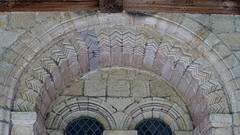
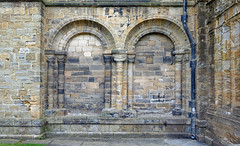
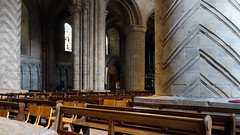
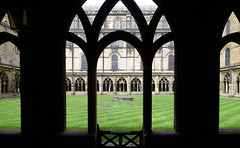

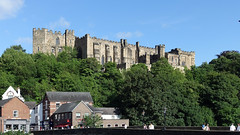
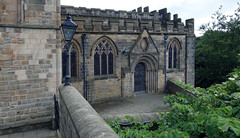
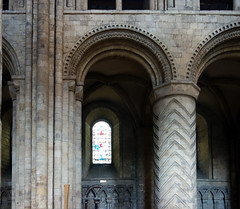
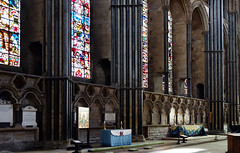
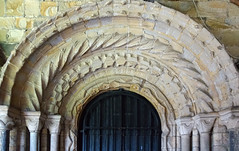
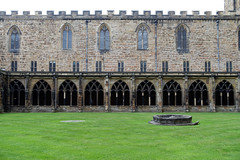
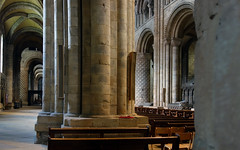
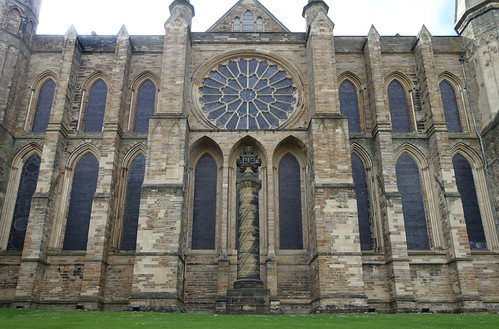
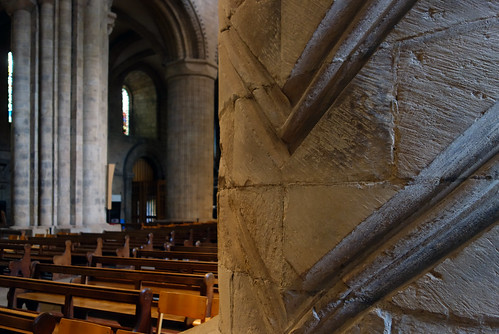
The Morgan Leaf from The Winchester Bible
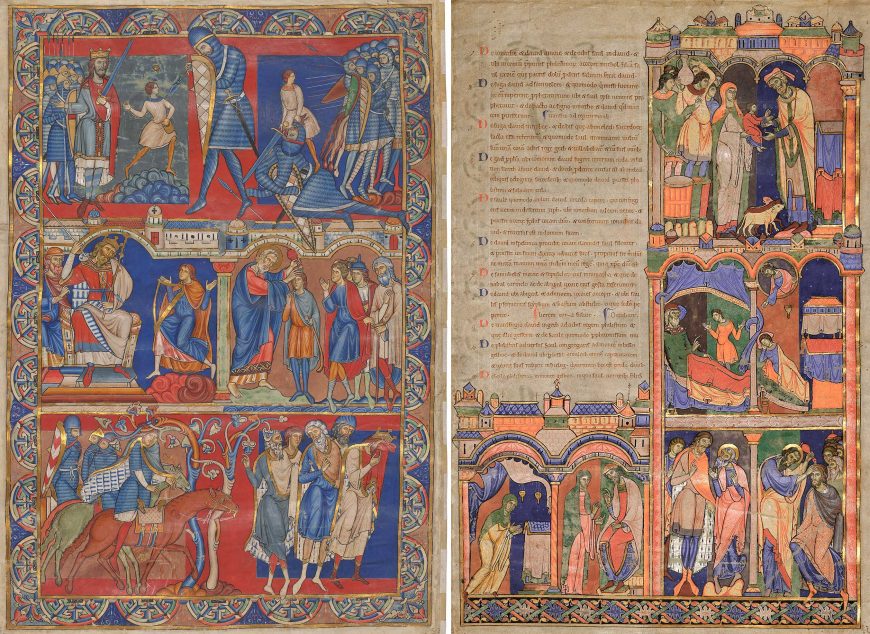
The page above, known as the Morgan Leaf, comes from the Winchester Bible, one of the most magnificent illuminated manuscripts to have been made in England in the twelfth century. The Morgan Leaf, which is now in the Morgan Library & Museum in New York (hence its name) was originally inserted as a frontispiece to the Book of Samuel in the Winchester Bible.
The Winchester Bible (below) was made at the Cathedral priory of St. Swithun’s at Winchester, England and is still at Winchester (where it is normally on display—though without the Morgan Leaf).
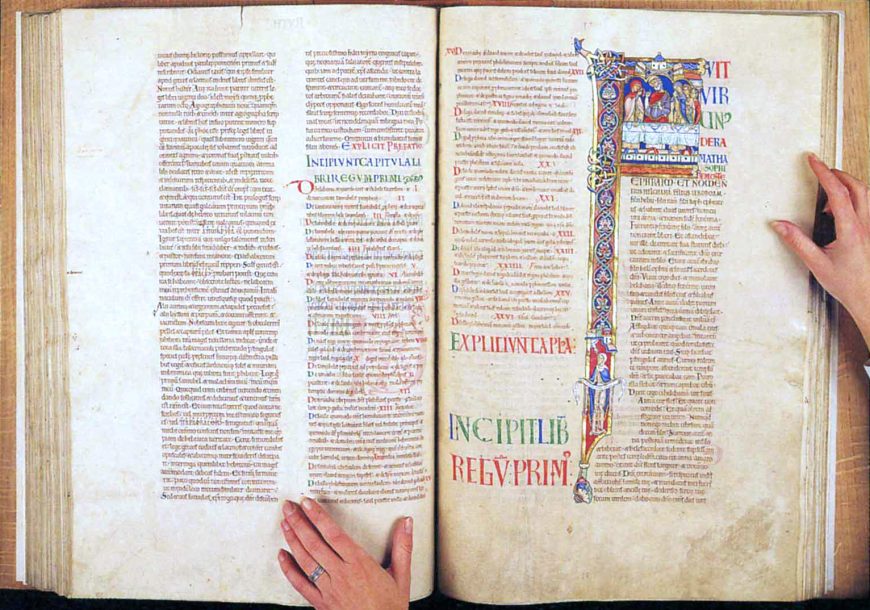
The Winchester Bible is an example of a type of book known as a giant bible, a large format manuscript that originated in Italy in the mid-eleventh century and contained the entire text of the Christian bible from the Book of Genesis to Revelation. Giant bibles were deemed to be essential to monastic communities during the Romanesque period. Its importance should be seen within the context of the Gregorian reform movement, named after Pope Gregory VII, who ruled from 1073 until 1085. Gregory initiated reforms in the late eleventh century requiring that monks have access to an accurate version of the entire text of the Bible. Prior to the eleventh century, entire texts of the Bible were relatively rare.
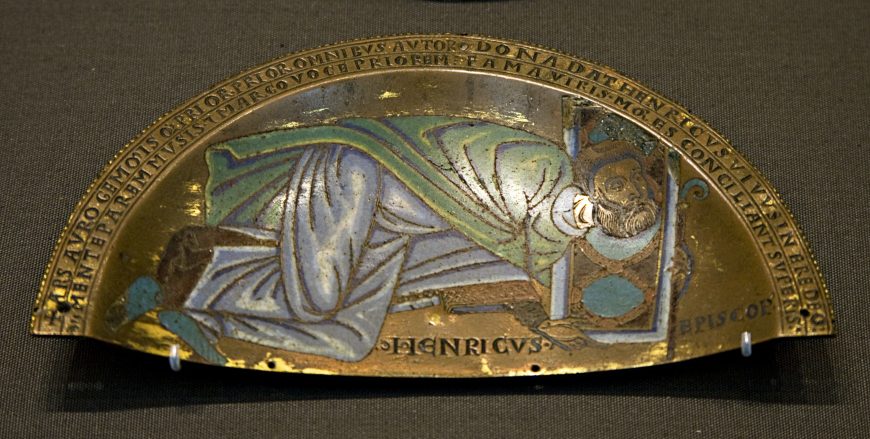
Figure \(\PageIndex{141}\): Henry of Blois, Bishop of Winchester, presenting an altar, before 1171, semi-circular plaque (part of a set of two), copper alloy, champlevé, gilding, 18.2 cm (The British Museum), photo: Ealdgyth, CC BY-SA 3.0
The translated inscription reads: Art comes before gold and gems, the author before everything. Henry, alive in bronze, gives gifts to God. Henry, whose fame commends him to men, whose character commends him to the heavens, a man equal in mind to the Muses and in eloquence higher than Marcus [that is, Cicero]
It is generally assumed that the patron of the Winchester Bible was Henry of Blois, the bishop of Winchester, and one of the most powerful men in England. There is, however, no conclusive proof of this, and his patronage has recently been questioned with the alternate suggestion that King Henry II may have played a role in supporting production of this lavish manuscript. Royal patronage may explain some of the imagery seen in the Morgan Leaf.
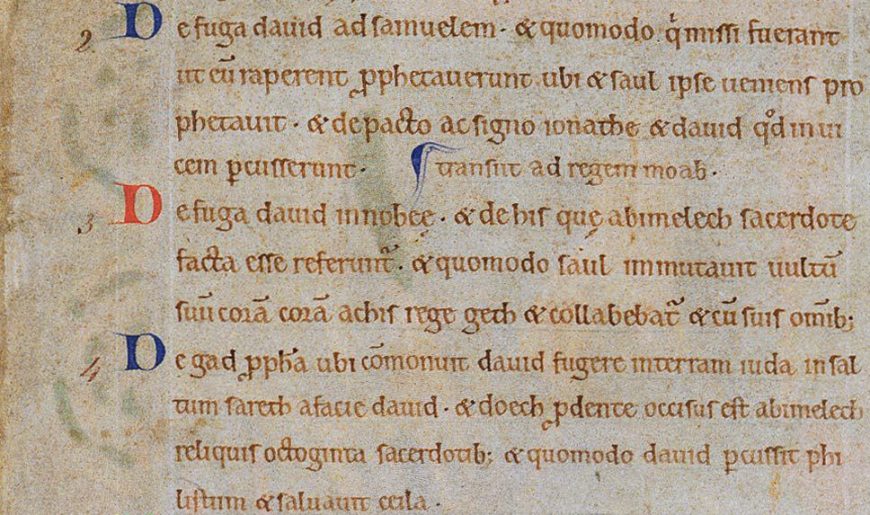
The Winchester Bible is written on parchment made from calf skin. It has been estimated its production would have required the skin of over 250 calves, and so this would have been an exceptionally expensive book to produce—not even accounting for the skilled labor of the scribe and the illuminators. The entire text of the Bible was written in one beautifully rounded hand (which can be seen on the verso of the Morgan Leaf). The writing would have been a formidable task, and it has been estimated that the project would have taken at least four years. The scribe was most probably a monk from the monastic community at St. Swithun’s, though lay scribes have also been recorded at work at Winchester.
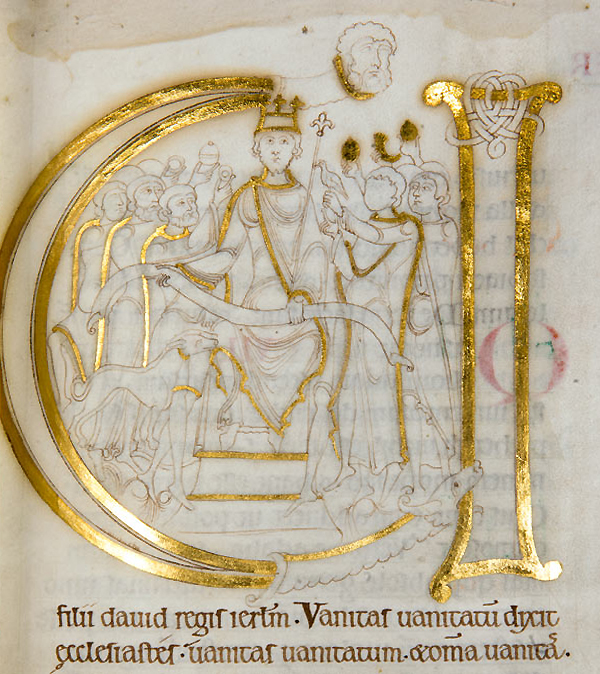
Illustrating the Winchester Bible appears to have been a more complicated affair. The intention was to prefix each book of the Bible with an historiated initial (one with a figurative illustration in it), usually related to the text. As an afterthought, full-page frontispieces to three books of the Bible were added (one of which is the Morgan Leaf). The illustrations were drawn and painted by at least six different artists, probably working in two separate and consecutive teams, yet in spite of this, the program of illustrations was left incomplete, with many illustrations left half-painted or only under-drawn. The six artists remain anonymous, but names have been invented to distinguish their different styles. The two responsible for the Morgan Leaf are know as the Master of the Apocrypha Drawings and the Master of the Morgan Leaf.
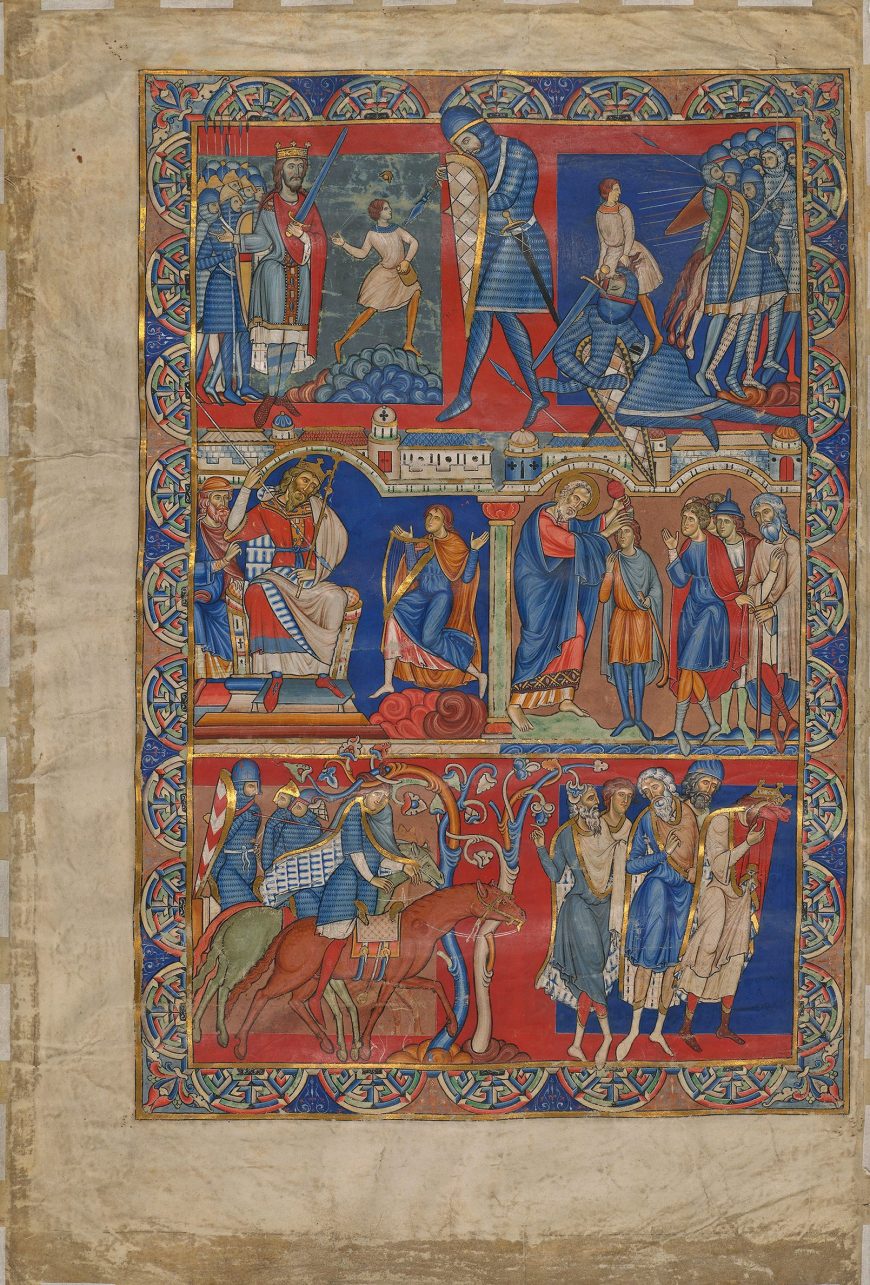
The scenes on the Morgan Leaf are set against colored, paneled backgrounds that visually project them forward. The artist uses a characteristic narrative device of the period, arranging scenes in pairs, with the first representing the scene before, and the second the scene after. The scene in the top register on the left, for example, represents the diminutive figure of David who is shown slinging the stone at the giant Goliath, while on the right, he cuts off the head of Goliath as the Philistines flee.
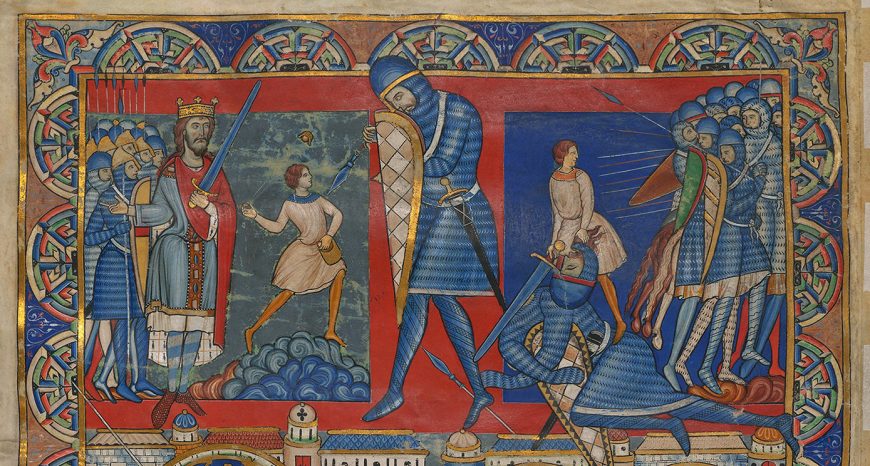
Notice that David is represented clothed but without armor, conforming to the biblical account, but not, as in later Renaissance representations, naked. In the second register, David is represented on the left, playing the harp in front of King Saul, who in a fit of jealousy throws a spear at him. In the pendant image on the right, David is anointed Saul’s successor by the priest Samuel, after Saul commits suicide. In the bottom register on the left, Absalom, the son of David, is put to death, and in the final scene, to the right, David is informed of the death of his son and weeps in grief.

It has been suggested that this event parallels one in the life of King Henry II as his own son and heir, Henry the Young King, revolted against him and in the process lost his life, which caused Henry great grief. One distinctive feature is the striped, chequered, and chevron patterns on the shields. This has been identified as a form of proto-heraldry, which had its origins in the practice of attaching cloth coverings to shields so as to distinguish between combatants dressed in armor who would otherwise not have been easily identifiable.
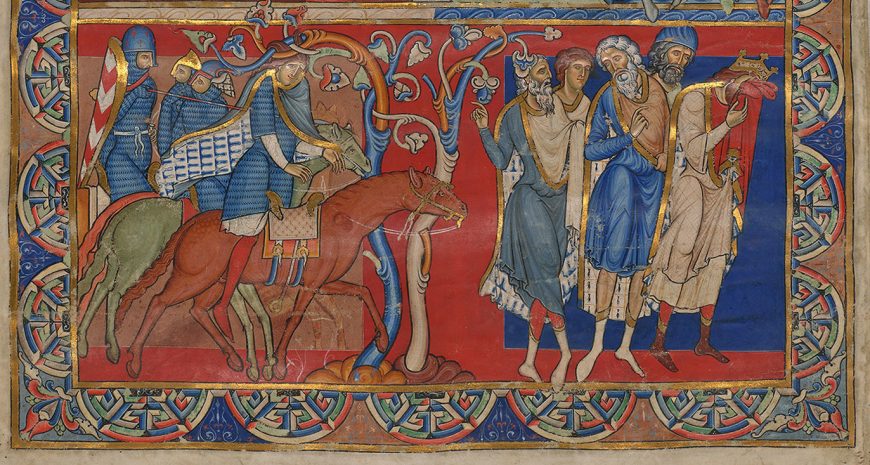
In its execution, there is a division of labor in the illumination of the leaf, with the underdrawing done by the Master of the Apocrypha Figures, and the painting largely done by the Master of the Morgan Leaf. Of these, the more traditional was the Master of the Aprocrypha drawings, who belonged to the first team of artists, and, it has been suggested, worked earlier at the monastery of St. Albans north of London. The more precocious of the two artists, the Master of the Morgan Leaf, belonged to the second team. The Master of the Morgan Leaf appears to have been a more cosmopolitan artist than his predecessor. The painter was almost certainly a lay professional, an itinerant artist who moved from one international center to another.
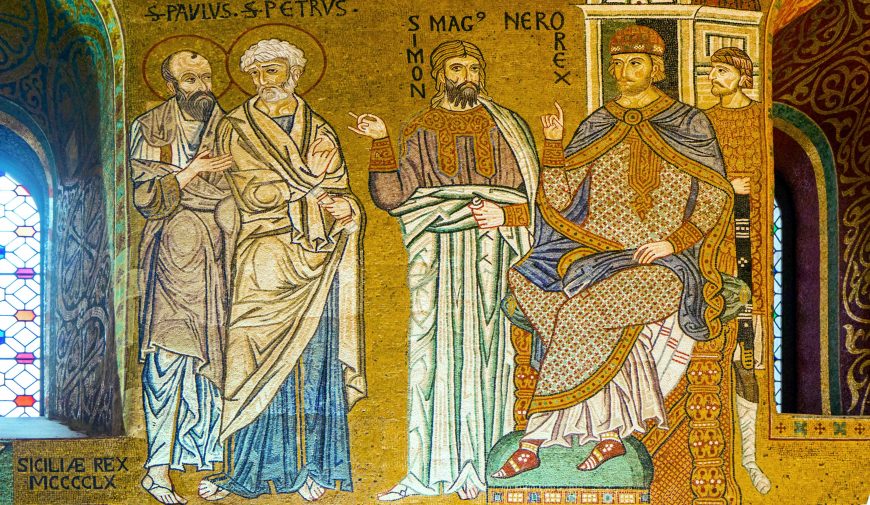
It has been postulated that the Master of the Morgan Leaf had seen the monumental mosaics in Sicily in the Palatine chapel at Palermo and the abbey at nearby Monreale, which had only recently been installed. It is thought that he translated the Byzantine style and imagery he had seen there into the medium of manuscript illumination. His hand has also been identified in the wall-paintings in the royal convent of Sigena in Aragon in northern Spain, which must have been painted after he left Winchester.
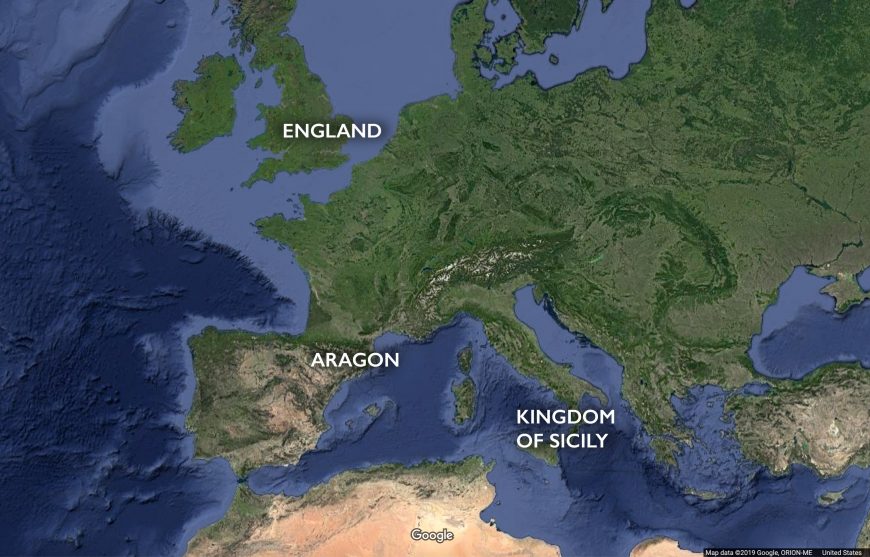
During this period, England, Sicily, and Aragon were closely linked through dynastic ties and England was far more open to international influences than in the previous Anglo-Saxon era, with the Angevin empire of Henry II extending as far as the south of France. The painting of the Morgan leaf is unprecedented in English art in its naturalism and representation of human emotions, especially pathos and grief. This artistic expressiveness anticipates, by a century, the work of Duccio in Italy.
The chronology of the Bible’s execution has been the subject of dispute. It is generally thought to have been begun about 1160, but its terminal date is more controversial, with some experts favoring a date in the 1170s, corresponding to the death of Henry of Blois in 1171, while others think work may have continued beyond this date into the 1180s. The recto of the Morgan Leaf is divided into three horizontal registers, a format that recalls the great gospel books made at the monastery of Echternach, now in Luxembourg, which in the eleventh century formed part of the Holy Roman Empire. One of these manuscripts may have been in England in the twelfth century and functioned as an exemplar for the page format for the Morgan Leaf.
Additional resources:
The Morgan Leaf at the Morgan Library & Museum
Claire Donovan, The Winchester Bible (British Library: London, 1993)
Christopher Norton, “King Henry II, St Hugh, and the Winchester Bible,” in Romanesque patrons and processes : design and instrumentality in the art and architecture of Romanesque Europe, edited by Jordi Camps i Sòria, Manuel A. Castiñeiras, John McNeill and Richard Plant (London: Routledge, 2018)
National Manuscripts Conversation Trust regarding the manuscript
Morgan Library & Museum conservation poster regarding the Morgan Leaf
The Winchester Bible exhibition blog at The Metropolitan Museum of Art
Three lectures on The Winchester Bible (2015) with:
• Charles T. Little, Metropolitan Museum of Art
• Stephen Murray, Columbia University
• Christopher de Hamel, University of Cambridge
Romanesque art in Spain
Some of the most beautiful Romanesque art was created in Catalonia (in northeast Spain), and much of it can be seen today in the National Museum of Catalan Art located in Barcelona.
c. 1000 - 1200
Historiated capitals, Church of Sant Miquel, Camarasa
by DR. BETH HARRIS and DR. STEVEN ZUCKER
Video \(\PageIndex{8}\): Historiated capitals from the crossing of the Church of Sant Miquel of the castle of Camarasa, Noguera (Spain), early 13th century, stone, 77 x 1.65 x 77.5 cm (Museu Nacional d’Art de Catalunya, Palau Nacional, Barcelona)
Smarthistory images for teaching and learning:
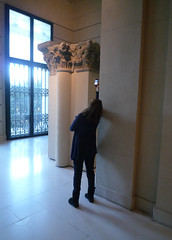
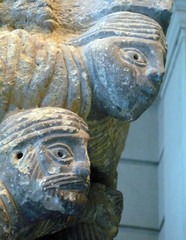
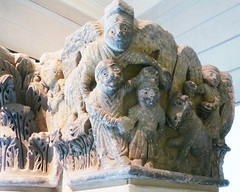
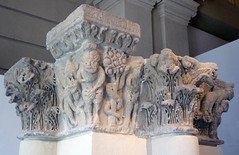
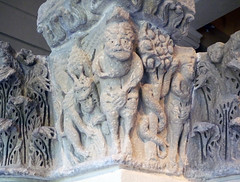
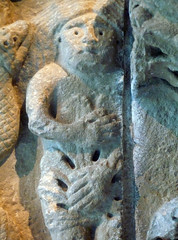
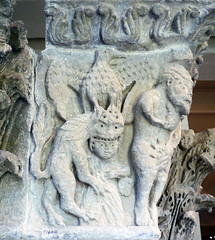
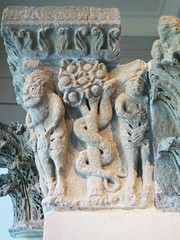
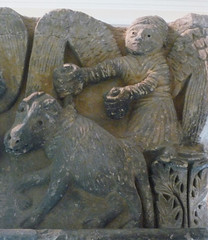
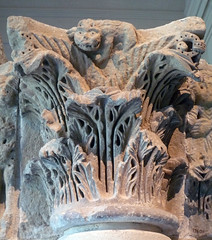
“Throne of Wisdom” sculptures
The Queen of Heaven
The image of the Virgin and Christ Child was ubiquitous in medieval art. Architectural and portable sculpture, altarpieces, stained glass windows, and other art works featured the Mother of God with her infant son. The Virgin Mary was regarded as the Queen of Heaven, the great intercessor between her Son and the helpless earthly souls who looked to her in time of need. The familiar Gothic depiction of an approachable Virgin as a beautiful young queen, standing in an S curve and delicately balancing the small Christ Child on her hip, was preceded by the more sober, rigid, and hieratic Romanesque depiction of a seated Virgin holding the Christ Child on her lap, a type referred to as a “Throne of Wisdom.” (This Romanesque type can be traced back to Byzantine depictions of Mary as “Theotokos” or the Mother of God).


A number of these sculptures have come down to us from the 12th century, though records indicate that earlier examples did exist. They are true sculptures in the round, made of wood, and usually measuring 3-4 feet in height. They were designed for mobility—carried in the many processions of the Middle Ages in celebration of feast days (a practice which continues in some parts of Europe to this day).
Believed to be a manifestation of the Virgin’s presence and authority, the sculpture was paraded around during times of war, famine, disease, or to simply collect money for the church. Like other portable sculpture of the Middle Ages (see the example, left), they were an essential part of communal religious life. We can only imagine the sounds of clashing cymbals-described by one witness in the early 11th century and the many desperate hands trying to touch the sculpture as she passed through the crowds.
Referred to as “Majesties” in contemporary texts, the sculptures are simple compositions in which the Virgin Mary sits on a throne with the Christ Child sitting on her lap. Strictly frontal with expressionless faces, both figures wear simple tunics, the ripples of which fall in perfect, repetitive patterns, resulting in a very stiff and symmetrical quality. Originally, the sculptures would have been polychromed over linen and gesso then decorated with tin leaf, with the more exquisite examples decorated with gold or silver leaf and adorned with gems.
“Throne of Wisdom” sculptures
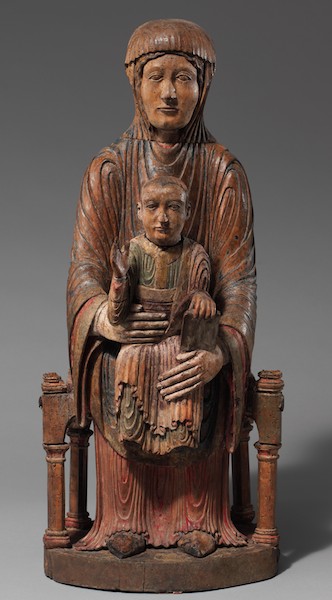
A good example of a “Throne of Wisdom” sculpture which still retains some of its original color is found at the Cloisters Museum, a branch of the Metropolitan Museum of Art in New York. The sculpture is made from several pieces of walnut doweled together. Originally, the Virgin wore a red robe covered by a dark blue mantle which was decorated with tin leaf to simulate gold. Christ’s tunic was originally a dark green with red lining, covered by a red overgarment known as a himation. This too was originally decorated with tin leaf.
The sculpture puts into visual form the typological tradition of comparing Mary to the Throne of Solomon (typology refers to the idea that events and individuals in the Old Testament prefigured those in the New Testament). King Solomon’s famous throne is described in the Book of Kings of the Old Testament as a throne of ivory covered in gold. Christ, like his ancestor King Solomon, embodies wisdom and justice. Thus, Mary is a Sedes Sapientiae or Throne of Wisdom—the Mother of God, enthroned herself, who serves as a throne for the son of God turned into human flesh. The Christ Child on her lap represents divine wisdom incarnate, whose wisdom is communicated through his adult features, making him look like a miniature man. The open bible he holds is also a representation of the divine wisdom he embodies.
To the medieval mind, the Throne of Wisdom statues were earthly manifestations of both the presence and the authority of the Virgin Mary. They were seen as a way to communicate with the heavenly court—relaying people’s prayers and interceding on their behalf. In fact, the statues were not thought to have been made by sculptors in workshops, but to be miraculous in origin. Stories range from one being discovered by woodcutters enclosed in a tree to one arriving on a ship without sailors or oars and enveloped in a bright light. They were also said to be immune to fire as a number of accounts attest of statues surviving church fires without even being scorched. According to one thirteenth century legend, a Throne of Wisdom statue was able to save itself from a burning church by leaping out of the window and into the arms of a count who was walking by!
The cult of relics
The Throne of Wisdom sculptures also functioned within the broader context of the growing cult of relics in medieval Europe. Relics are the physical remains, such as bones, strands of hair, teeth, etc, or secondary relics associated with Christ, the Virgin, martyrs, and saints. These secondary relics could include clothing, jewelry, instruments of torture, or anything that the saint had come in contact with while alive. As early as the 4th century, these remains and objects were said to possess miraculous powers. Hordes of pilgrims would visit various churches built over the tombs of saints or shrines with relics in hopes of being cured of disease, to atone for their sins, or to simply venerate the saint. Remains of martyrs and saints were frequently moved and divided so that new sites were established in places never associated with the saint.
There is ample evidence suggesting that the Throne of Wisdom sculptures were occasionally used as reliquaries (containers for relics). Our example from the Cloisters has a small circular cavity on the Virgin’s left shoulder and x-rays confirm a relic contained within. The relic may not necessarily be associated with the Virgin Mary (parts of her clothing or veil, strands of her hair, and drops of her milk were frequently cited relics), but could be fragments of another holy individual. Whatever the relic, its inclusion would have made the Virgin’s perceived intercessory power that much more effective.

Role in medieval theatre
It has been proposed that the sculptures also played an important role in the early days of medieval liturgical drama in which stories from the bible were enacted in a church for the mostly illiterate audience. One of the earliest plays was the Adoration of the Magi in which clerics dressed as the three kings and approached the Throne of Wisdom sculpture bearing gifts for the Christ Child. Explain Adoration of the Magi.
The surviving texts of these plays are very clear about who will play the roles of the three kings, Herod, the midwives, etc. but are silent with regard to the human representations of the Virgin and Child, only referring to them as an image. It seems that the use of human actors to represent Mary and Christ was considered inappropriate until the 15th century when it became acceptable. Thus, the Throne of Wisdom sculptures represented the Virgin and Child in the early days of medieval theatre, receiving the traditional gifts of gold, frankincense and myrrh from the clerics dressed as the three kings.
From reliquary to the star of a liturgical play, the Throne of Wisdom sculpture type is a good reminder that medieval religious art had multiple functions, and was didactic and spiritual at the same time.
Additional Resources:
Enthroned Virgin and Child at The Metropolitan Museum of Art
Pilgrimage Routes and the Cult of the Relic
Ilene H.Forsyth, The Throne of Wisdom:Wood Sculptures of the Madonna in Romanesque France (Princeton University Press, 1972).
Virgin from Ger
by DR. BETH HARRIS and DR. STEVEN ZUCKER
Video \(\PageIndex{9}\): Virgin from Ger, second half of the 12th century, from the parish church of Santa Coloma de Ger, Baixa Cerdanya (Spain), wood, tempera, and stucco, 51.8 x 20.5 x 15.5 cm (Museu Nacional d’Art de Cataunya Palau Nacional, Barcelona)
Smarthistory images for teaching and learning:

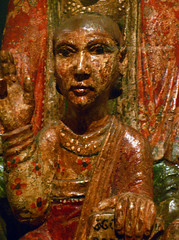
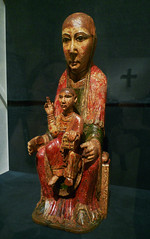
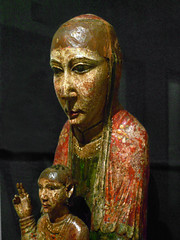
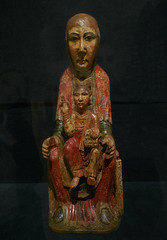
Circle of the Master of Pedret, The Wise and Foolish Virgins
by DR. BETH HARRIS and DR. STEVEN ZUCKER
Video \(\PageIndex{10}\): Circle of the Master of Pedret, The Wise and Foolish Virgins, south apse of the Epistle, Sant Quirze de Pedret, late 11th century to the beginning of 12th century, fresco transferred to canvas 325 x 315 x 320 cm (Museu Nacional d’Art de Catalunya, Barcelona)
Smarthistory images for teaching and learning:
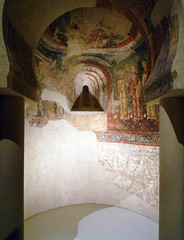
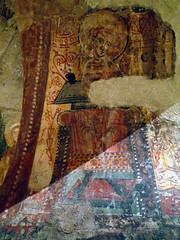
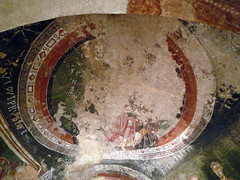

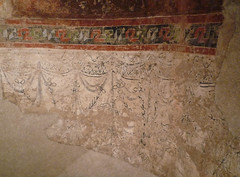
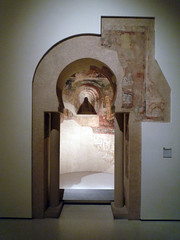
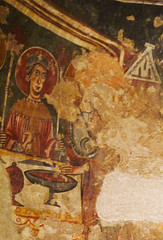
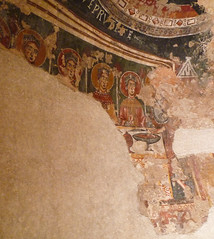

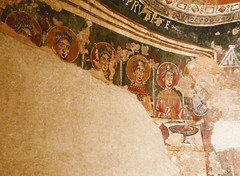
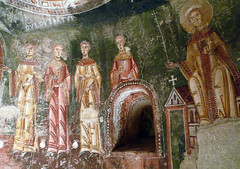

Camel from San Baudelio de Berlanga
by DR. LAUREN KILROY-EWBANK and DR. STEVEN ZUCKER
Video \(\PageIndex{11}\): Camel, first half of the 12th century, fresco transferred to canvas, from San Baudelio de Berlanga, Spain (Met Cloisters, New York)
Introduction
The Romanesque hermitage of San Baudelio de Berlanga was built in the eleventh century in the border zone of Islamic and Christian territories in what is today Spain. While it may seem isolated today, in the eleventh century it was situated on an old Roman road that came from southern France that bustled with activity. It brought merchants as well as pilgrims going to visit the relics of the early Christian martyr St. Baudilus in Nîmes. The hermitage’s architectural style is often called mozarabic, a term used to describe Christians living under Muslim rule and who drew from Arabic visual culture.
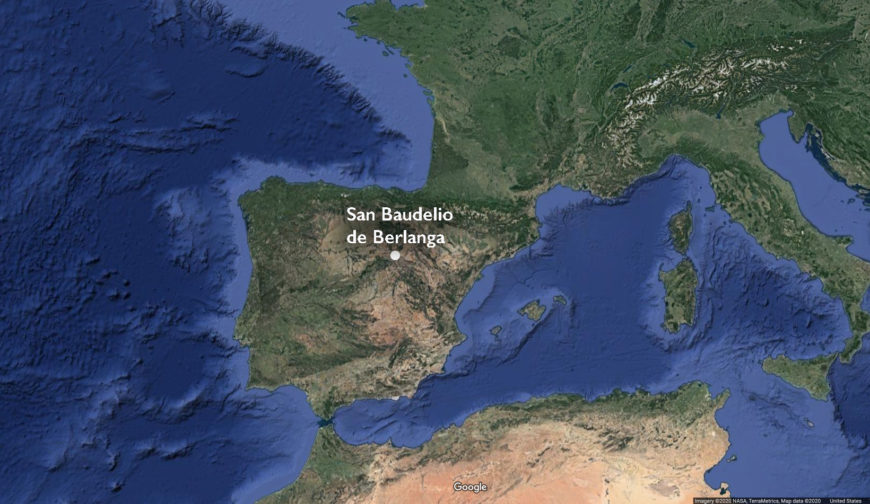
More than a century later, the building’s interior was transformed with the addition of brightly painted frescoes. In the upper levels are scenes from the life of Christ. Below, and painted on a larger scale, are more secular scenes of animals, hunting, and illusionistic silk tapestries. Among the animals depicted is a camel seen in profile. The animals suggest the complex history of medieval Spain, because they are based on animals seen on Islamic luxury goods (such as ivories, metal objects, ceramics, and textiles).
Construction of the hermitage and the painting of the murals occurred during an important moment in medieval Spain, one which saw boundaries shifting between faiths and rulers. Since 711, much of the Iberian Peninsula (today, Portugal and Spain), had been ruled by the Umayyad caliphate. The Umayyads were heirs to Muhammad, who had initiated the spread of the faith of Islam in the 6th century. The Umayyads created a vast empire that spanned much of the eastern and southern Mediterranean world, and eventually they reached the Iberian Peninsula (Spain and Portugal) in 711. After seven years, they had conquered much of it from the Christian Visigoths. These new Muslim territories were called al-Andalus. Then, in 750, the Umayyads were supplanted by the Abbasids. The last ruler of the Umayyads fled to al-Andalus, creating a new dynasty there with Córdoba as its capital. It was called the caliphate of Cordoba. Al-Andalus would develop rich, complex artistic traditions—the result of a diverse population that included Christians, Jews, and Muslims.
Still, Christians would try to reconquer the Iberian Peninsula after 711, in what has been called the Spanish Reconquest. The ensuing centuries would mean that the borders between al-Andalus and Christian-ruled Iberia would frequently change. San Baudelio de Berlanga was initially built in a frontier zone, and then when it was painted in Christian-controlled kingdom. A sign that Christians were gaining ground in acquiring territories came in 1085, when King Alfonso VI conquered the important city of Toledo.
Umayyad rule ended in 1031 after Christian forces were finally able to defeat the powerful caliphate. What remained of southern Al-Andalus would be divided into taifas (independent principalities). (Despite the downfall of the Umayyads, other Muslim rulers would establish themselves on the Iberian Peninsula until 1492). Still, the murals–which would have been painted when the hermitage was more associated with a Christian kingdom–demonstrate that artists continued to draw on Islamic courtly arts.
Today, most of the hermitage’s murals are not in their original location, but were removed from the walls in the 1920s, mounted onto canvas, and acquired by different museums, including the Prado (Madrid), Cloisters (NYC), the Indianapolis Museum of Art, and the Museum of Fine Arts, Boston.
Terms and key ideas
- Al-Andalus, the Umayyads, and Islamic art in Spain
- Spanish Reconquest
- Romanesque murals
- Frontier zone
- Sacred and secular art
Test yourself with a quiz!
START
Additional resources:
Read about the camel fresco on The Metropolitan Museum website
Read more about Romanesque art on Smarthistory
Jerrilynn Dodds, ed., Al-Andalus: The Art of Islamic Spain (New York: The Metropolitan Museum of Art, 1992)
Mojmir S. Frinta, “The Frescoes from San Baudelio De Berlanga.” Gesta 1/2 (1964): 9–13.
Charles T. Little, ed. The Art of Medieval Spain, A.D. 500–1200 (New York: The Metropolitan Museum of Art, 1993).
Elías Teres Navarro, El expolio de las pinturas murales de la ermita mozárabe de San Baudelio de Berlanga (Goya, 2007).
L. Schrader, “A Medieval Bestiary.” The Metropolitan Museum of Art Bulletin 44, no. 1 (Summer 1986).
For the classroom
Take notes while watching the video, using the Camel active note-taking activity.
Discussion questions
- What does the camel fresco reveal about Romanesque art in Spain?
- How does the camel fresco compare to other examples of Spanish Romanesque art, such as the frescoes of the Circle of the Master of Pedret or the historiated capitals of Sant Miquel, Camarasa?
- What similarities are there between the camel fresco and the Pyxis of al-Mughira?
- How do the camel fresco, synagogues of Toledo, and Book of Morals of Philosophers reveal the complex culture of medieval Spain?
Research topics
- Art created in frontier zones often displays amazing innovations and adaptations as a result of entangled cultural and visual practices. What does studying art made in these so-called frontier zones (including such spaces as San Baudelio de Berlanga and the Church of St. Nicholas, Balinesti in Romania), reveal about the Middle Ages?


